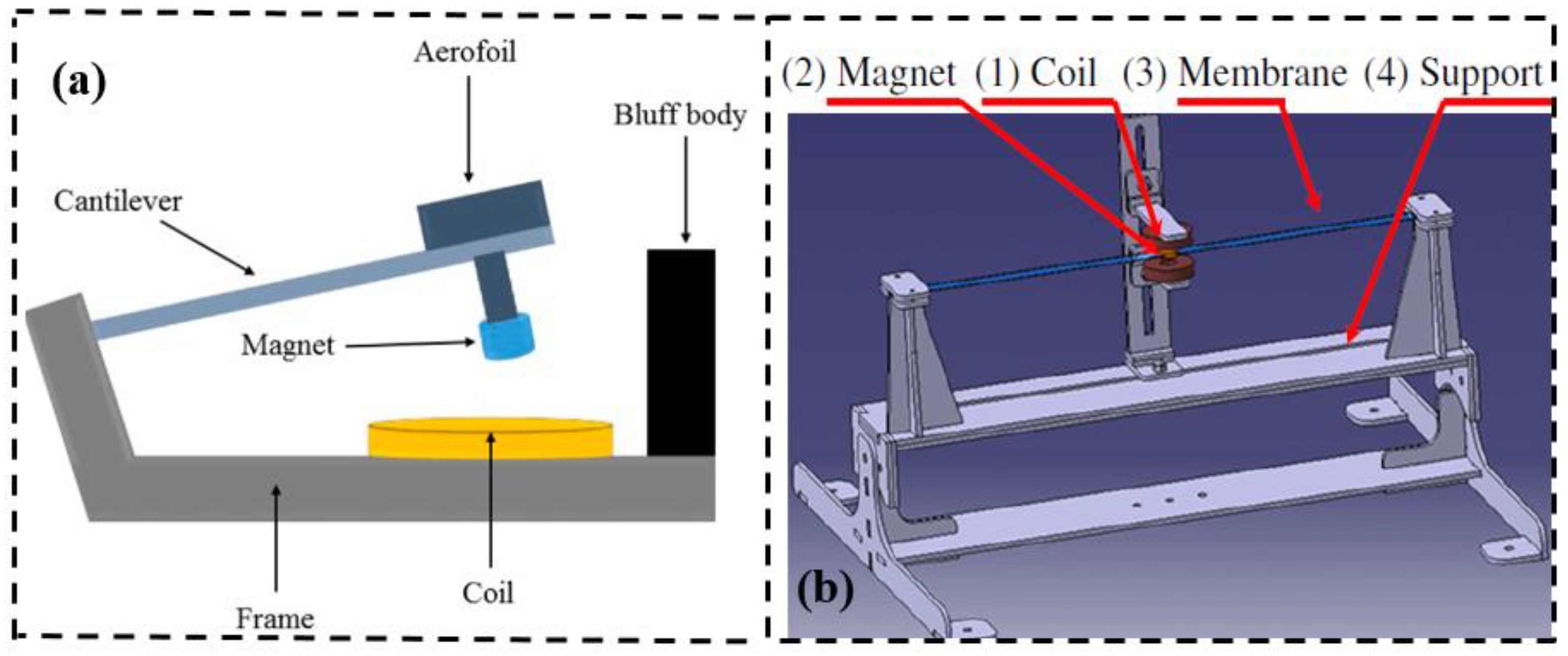Fluid Flow-Based Vibration Energy Harvesters: A Critical Review of State-of-the-Art Technologies
Abstract
1. Introduction
| Wireless Sensors | Company | Model Type | Measurement Range | Supply Voltage (V) | Supply Current (mA) | |
|---|---|---|---|---|---|---|
| Pressure | MICROSENSOR Corporation, ShanXi, China | MPM286 | 20–3500 kPa | 2.0 | ||
| Freescale Semiconductor, Austin, TX, USA | MXP 5700 | 0–700 kPa | 5 | 10 | ||
| ALTHEN Sensors and Control, Belgium, The Netherlands | MDM6861 | 0–35 kPa | 3.6 | - | ||
| HOLYKELL, HuNan, China | H2600 SERIES | 1–100 MPa | 3.6 | |||
| Temperature | MONNIT, Salt Lake City, UT, USA | ZTL-G2SC1 | −40–85 °C | 3 | 2.5 | |
| ALTHEN Sensors and Control, Belgium, The Netherlands | MDM6861 | −50–150 °C | 3.6 | - | ||
| TEXAS Instruments, Dallas, TX, USA | TMP100 | −55–125 °C | 2.7 | 0.075 | ||
| TEXAS Instruments, Dallas, TX, USA | LM61 | −25–85 °C | 2.7 | 0.125 | ||
| Flow | FLUIGENT, Ile-de-France, France | FRP | 7 nL/min–5 mL/min. | - | - | |
| MICROCHIP, Chandler, AZ, USA | YF-S201 | 1–30 L/min | 4.5 | 15 | ||
| OMEGA, Norwalk, CT, USA | FD-400 | 0.05–9.14 m/s | 5 | - | ||
| Spire Metering Technology, New Jersey, NJ, USA | EF10 | −10–10 m/s | - | - | ||
| Humidity | OMEGA, Norwalk, CT, USA | UWRH2 | 2–98% RH | 3.6 | ||
| MONNIT, Salt Lake City, UT, USA | MNS2-9W1-HU-RH | 0–100% RH | 3 | 2.5 | ||
| Combined Humidity, Pressure and Temperature Sensor | BOSCH, Gerlingen, Germany | BME280 | For humidity: 0–100% RH For pressure: 300–1100 hPa For temperature: −40–85 °C | 3.6 | For humidity and temperature 0.0028 For pressure: 0.0042 | |
| Humidity and Temperature Sensor | SENSIRION, Stäfa, Switzerland | SHT3x-DIS | For humidity: 0–100% RH For temperature: −40–125 °C | 2.5–5.5 | 1.5 | |
| Humidity and Temperature Sensor | SILICON LABS, Austin, TX, USA | Si7020-A20 | For humidity: 0–100% RH For temperature: −40–125 °C | 3.6 | For humidity: 0.18 For temperature: 0.12 | |
2. Flow-Induced Vibrations (FIVs) and Energy Harvesting
2.1. Aeroelastic Instability and Structural Dynamics
2.2. Energy Transduction in Flow Energy Harvesting
3. Karman Vortex Street-Based Energy Harvesting
3.1. Karman Vortex Street-Based PE-FBEHs
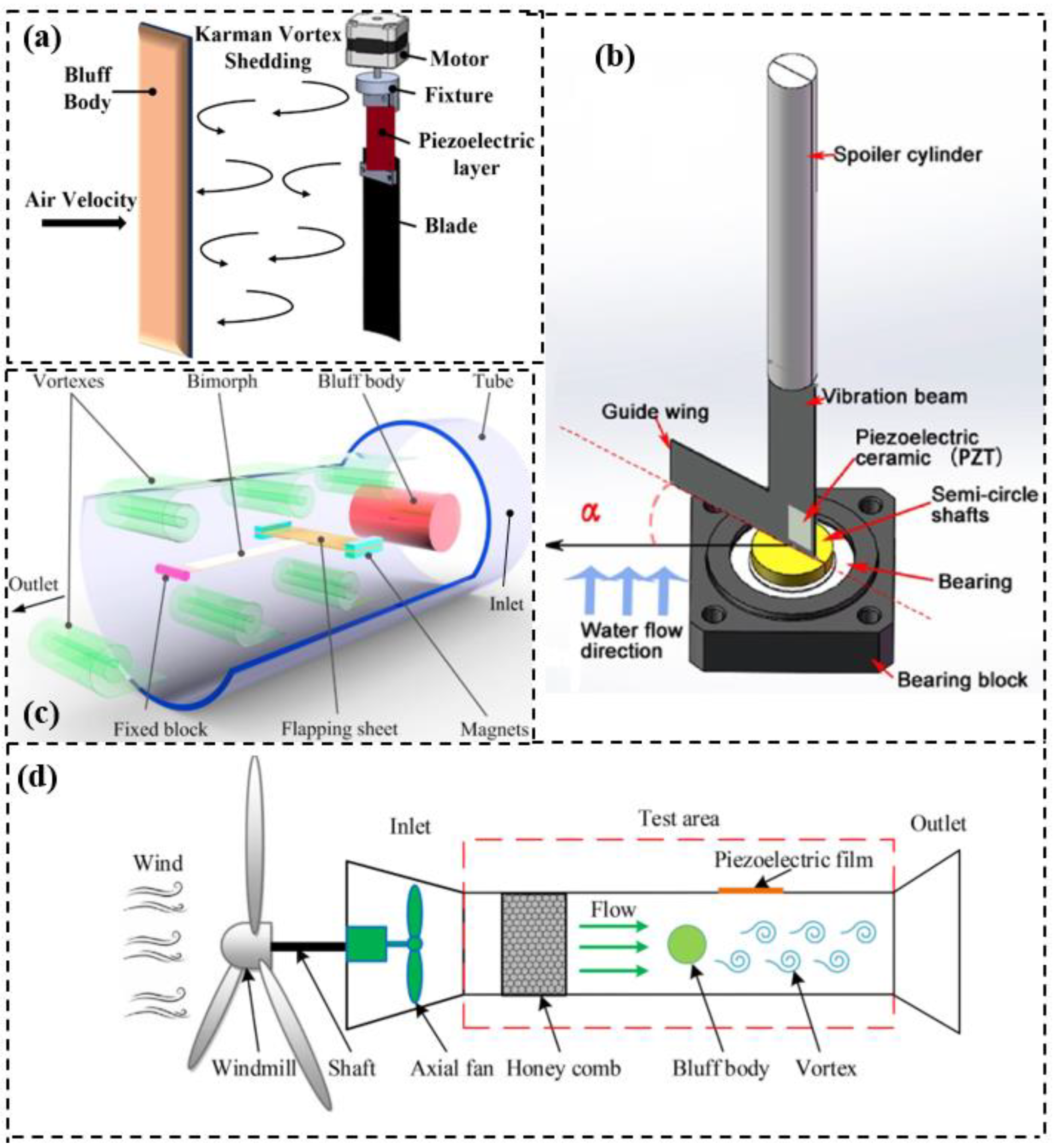
3.2. Karman Vortex Street-Based EM-FBEHs
3.3. Karman Vortex Street-Based TE-FBEHs
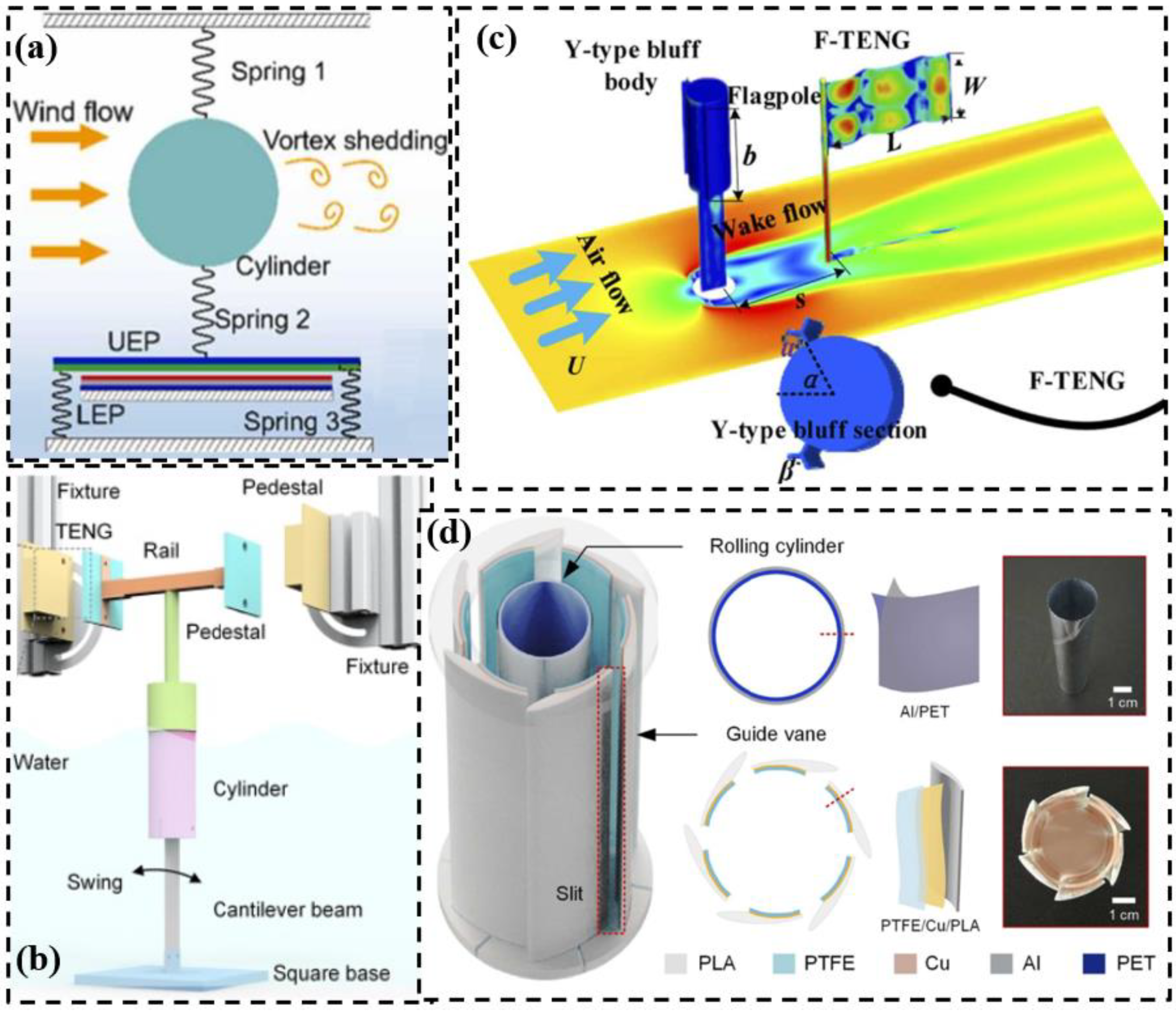
| Harvester Type | Fluid Velocity (m/s) | Output Voltage (V) | Resistance (kΩ) | Output Power (μW) | References |
|---|---|---|---|---|---|
| PE-Turbulence induced vibration | 7.125 | 100 | 4 | Akaydin et al. [41] | |
| PE-Water based | 0.35 | 125 | 84.49 | Song et al. [42] | |
| PE-Airflow based | 4 | 15 | 1300 | Demori et al. [43] | |
| PE-Flapping sheet | 2.4 | 19.2 | 12 | 15,300 | Hu et al. [48] |
| PE-Micro windmill | 19 | 5.06 | 650 | 8.97 | Du et al. [49] |
| PE-Rotational wind EH | 12 | 10 | 100 | 1000 | Zhou et al. [54] |
| EM-Water based | 1.38 | 0.02 | 0.038 | 1.77 | Wang et al. [57] |
| TE-Wind induced vibration | 2.78 | 536 | 83,300 | 392.72 | Zhang et al. [59] |
| TE-Water based | 0.5 | 174 | 1000 | 2500 | Li et al. [61] |
| TE-Flag type | 6 | 8000 | 2.9 | Han et al. [62] | |
| TE-Rolling based mechanism | 8 | 120 | 40,000 | 1940 | Choi et al. [63] |
4. Galloping Energy Harvesting
4.1. Galloping PE-FBEHs
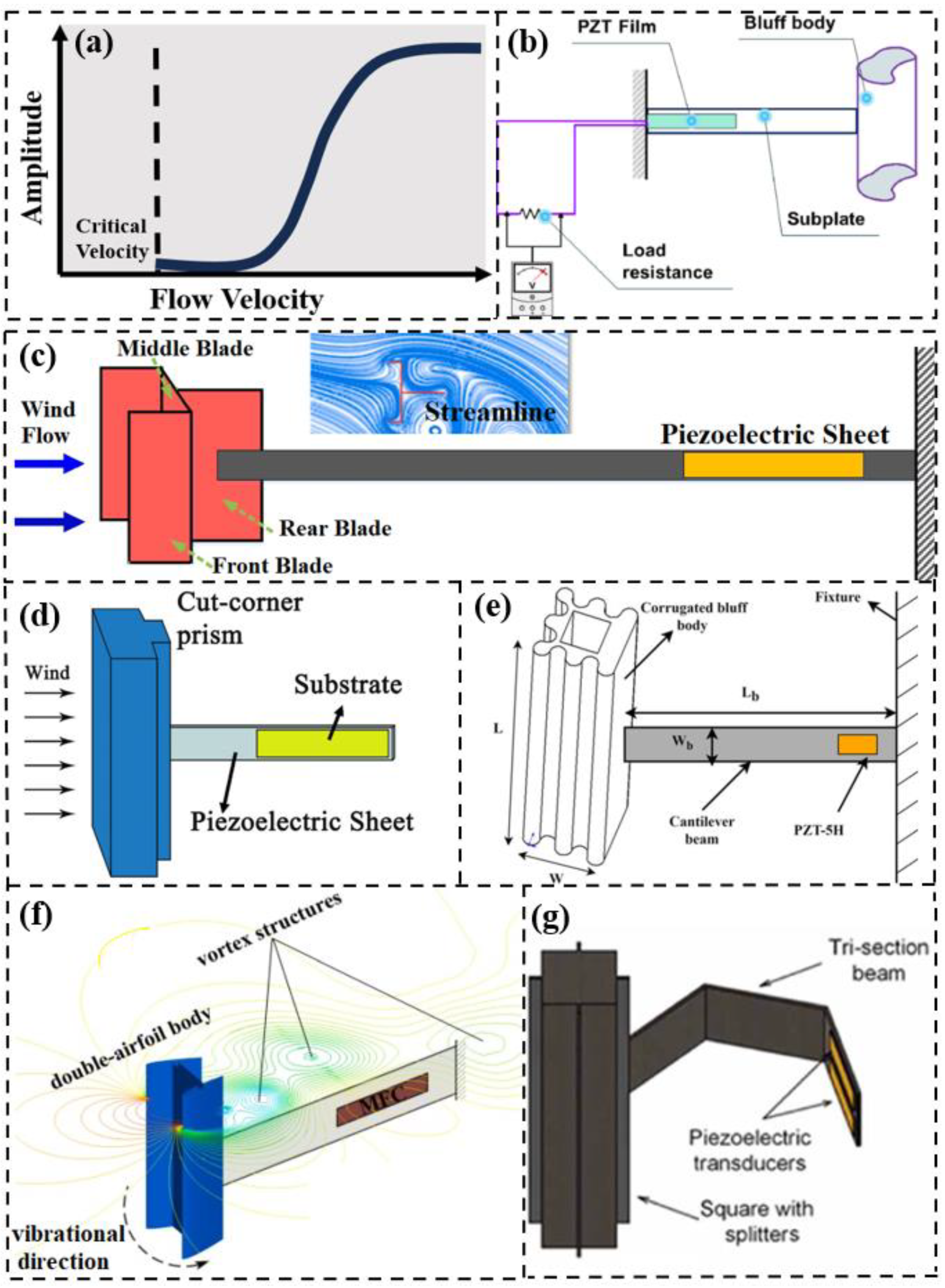
4.2. Galloping EM-FBEHs

4.3. Galloping TE-FBEHs
| Shape of the Bluff Body | Cut-in Velocity (m/s) | Optimum Resistance (kΩ) | Velocity at Max Power (m/s) | Voltage (V) | Output Power (mW) | References |
|---|---|---|---|---|---|---|
| PE-FEHs | ||||||
| Square | 2.5 | 105 | 8 | 8.4 | Yang et al. [65] | |
| Square with fins | 5000 | 5 | 0.034 | Hu et al. [72] | ||
| Y-shape | 1 | 1000 | 5 | 40 | 1.6 | Liu et al. [74] |
| Fork-shape | 1.5 | 1000 | 5 | 32 | 1.07 | Liu et al. [75] |
| Y-shape | 1.32 | 2006 | 2.098 | 1.19 | Wang et al. [76] | |
| Curved plate | 1.8 | 820 | 5.5 | 10.7 | 0.0356 | Zhou et al. [78] |
| Splitter plate | 3 | 0.593 | 7 | 14.8 | Noel et al. [80] | |
| Square | 1.9 | 2730 | 4 | 0.018 | Jo et al. [81] | |
| Square with V-shaped grooves | 3.04 | 9 | 10 | 0.93 | Zhao et al. [82] | |
| Square with V-shaped grooves | 1.75 | 180 | 9 | 15.24 | Siriyothai et al. [83] | |
| Cut-corner prism | 3.8 | 100 | 6.24 | 47.5 | Want et al. [84] | |
| Funnel shape | 7 | 300 | 24 | 4.3 | Zhao et al. [85] | |
| Hyper-structure corrugated | 3 | 6 | 0.89 | 31.3 | Yuan et al. [86] | |
| Double bluff body | 0.96 | 2000 | 15 | 90.35 | 2.57 | Wang et al. [87] |
| Double-airfoil | 1.5 | 411.2 | 8 | 163.39 | 26.67 | Liu et al. [88] |
| Elliptical | 0.3 | 4000 | 0.55 | 38.4 | 4.2 | Hu et al. [90] |
| EM-FEHs | ||||||
| D-shape | - | 0.3 | 3.25 | 0.105 | 0.037 | Ali et al. [92] |
| Y-shape | 1.5 | 0.3 | 4 | 1.4 | 2.5 | Zhang et al. [93] |
| Square | 3 | - | 14 | 0.103 | 0.79 | Xiong et al. [94] |
| Y-shape | 2.75 | 0.044 | 10 | 0.118 | 0.31 | Kim et al. [95] |
| Hollow square tube | 1.6 | 1.2 | 4 | 3.2 | 7.8 | Su et al. [96] |
| TE-FEHs | ||||||
| Y-shape | 1.4 | 50,000 | 6 | 200 | 0.01 | Zhang et al. [97] |
| Trapezoid | 2.9 | 44,000 | 7.8 | - | 1.3 | Zeng et al. [98] |
| Fishtail-shaped | 0.24 | - | 0.89 | 313 | - | Zhang et al. [99] |
5. Flutter Energy Harvesting
5.1. Flutter PE-FBEHs

5.2. Flutter EM-FBEHs
5.3. Flutter-Based TEEHs
5.4. Bio-Inspired Flutter FBEHs

| Fluttering Mechanism | Cut-in Velocity (m/s) | Optimum Resistance (kΩ) | Velocity at Max Power (m/s) | Output Power (mW) | References |
|---|---|---|---|---|---|
| PE-FEHs | |||||
| Flag flutter | - | 66.6 | 25 | 1.12 | Eugeni et al. [110] |
| Additional wake | 6.6 | 39 | 10.6 | 0.00681 | Agarwal et al. [111] |
| Flag flutter | 5 | 500 | 20 | 0.746 | Latif et al. [112] |
| Leaf flutter | - | 1000 | 7 | 0.157 | Al-Haik et al. [132] |
| - | 680 | 7.5 | 0.54 | Liu et al. [133] | |
| Leaf flutter | 2 | 220 | 3 | 0.00076 | Wang et al. [135] |
| EM-FEHs | |||||
| Cantilever spring | 2.5 | 4.7 | 5 | 1.6 | Zhu et al. [113] |
| - | 4 | - | 8 | 1.1 | Park et al. [114] |
| Wind belt-type | 3 | - | 7 | 50 | Quy et al. [115] |
| Wind belt-type | 3 | 0.6 | 10 | 0.705 | Lu et al. [117] |
| TE-FEHs | |||||
| Flag-type | 6500 | 22 | 135 mW/kg | Zhao et al. [119] | |
| Multi-layered membrane | 7000 | 4 | 0.00033 | Phan et al. [120] | |
| Flapping-type | 18,000 | 14 | 67 | Liu et al. [121] | |
| Parallel-structured | 4000 | 25 | 0.82 | Lin et al. [122] | |
| Leaf-flutter | 11,000 | 7 | 17.9 | Feng et al. [123] | |
| Flag-type | 0.5 | 198,000 | 4.5 | Ravichandran et al. [124] | |
| Flag-type | 5000 | 7.5 | 0.03672 | Wang et al. [125] | |
| Rotary-flapping type | 9000 | 10 | 3.9 | Gao et al. [126] | |
| Wing flutter | 10,000 | 7.5 | 1.5 W/m2 | Ahmed et al. [130] | |
6. Wake Galloping Energy Harvesters
| Transduction Mechanisms | Cut-in Velocity (m/s) | Optimum Resistance (kΩ) | Velocity at Max Power (m/s) | Output Power (mW) | References |
|---|---|---|---|---|---|
| EM | 1.2 | 0.007 | 4.5 | 370 | Jung et al. [141] |
| PE | 1.55 | 27,000 | 9.8 | 0.003195 | Uttayopas et al. [143] |
| PE | 1.5 | 500 | 2.36 | 0.8 | Zhang et al. [144] |
| PE | - | 4300 | 7.6 | 0.7 | Yan et al. [146] |
| PE | 2.45 | 410 | 9 | 2.3 | Kim at al. [147] |
| TE | 1 | 100 | 1.8 | 0.3 | Yuan et el. [148] |
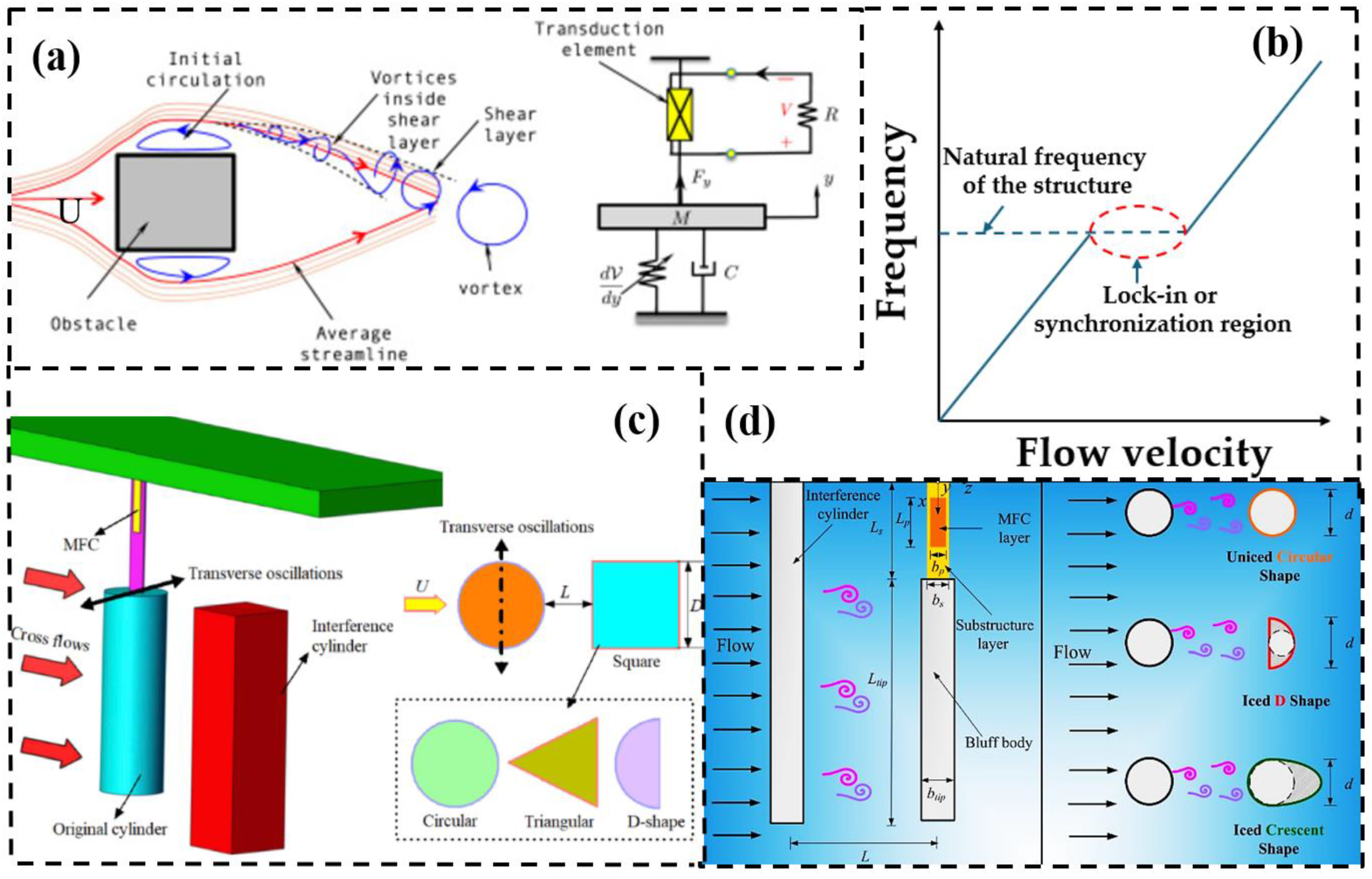
7. Enhancement Methods to Optimize and Increase the Efficiency of FBEHs
7.1. Nonlinear FBEHs
7.1.1. Nonlinear VIV-Based PE-FBEHs
7.1.2. Nonlinear Galloping PE-FBEHs
7.1.3. Nonlinear Flutter PE-FBEHs
| Type of FIV | Nonlinearity | Optimum Resistance (kΩ) | Velocity at Max Power (m/s) | Output Power (mW) | References |
|---|---|---|---|---|---|
| VIV | Buckled beam | 1000 | 14 | 0.0618 | Zhang et al. [152] |
| Magnetic nonlinearity | 50 | 3.2 | 0.15 | Zhang et al. [154] | |
| Magnetic coupling monostable | 500 | 1.6 | 0.21 | Hou et al. [155] | |
| Non-contact PEH | 300 | 40 | 1.438 | Wang et.al [156] | |
| Galloping | Magnetic nonlinearity | 600 | 7 | 0.73 | Wang et al. [165] |
| Nonlinear spring configuration | 504 | 4 | 35 | Sun et al. [166] | |
| Magnetic nonlinearity | 100 | 6.4 | 5.5 | Zhang et al. [167] | |
| Magnetic nonlinearity | 1000 | 10.2 | 0.49 | Ma et al. [168] | |
| Flutter | Cubic stiffness nonlinearities | 100 | 18 | 106 | Sousa et al. [169] |
| Self-sustained inverted flag | 10,000 | 9 | 5 mW/cm3 | Orrego et al. [172] | |
| Magnetic force-induced nonlinearity | 1000 | 3.1 | 0.07 | Li et al. [175] | |
| Structural nonlinearity | 100 | 5.5 | Elahi et al. [177] | ||
| Structural nonlinearity | 250 | 15.16 | 1.27 | Tian et al. [178] | |
| Structural nonlinearity | 250 | 14 | 3.382 | Tian et al. [179] |
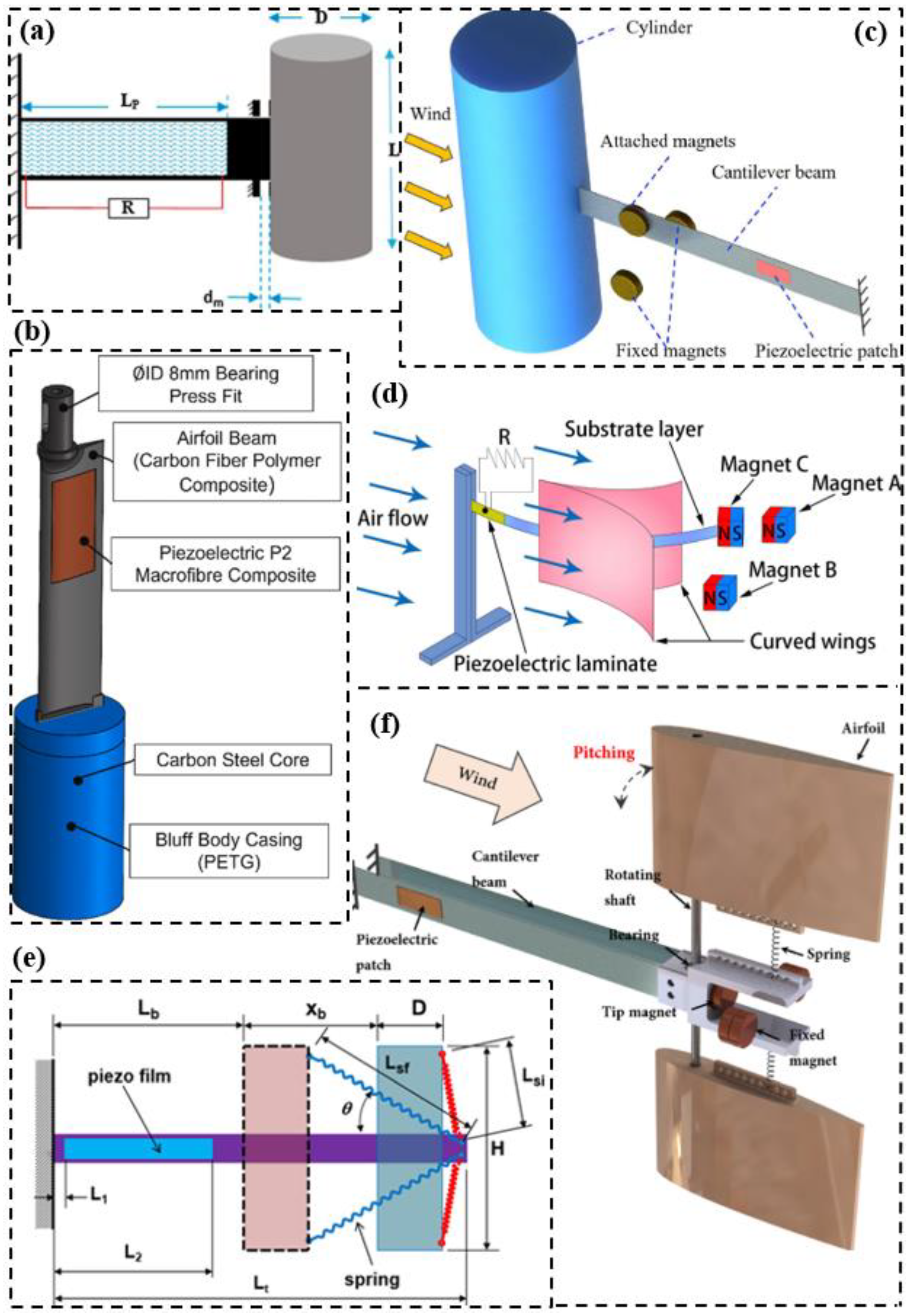
7.2. Multi-Transduction Mechanisms: Hybrid Flow Energy Harvesters (HFEHs)
| Harvester Type | Optimum Resistance (kΩ) | Velocity at Max Power (m/s) | Output Power (mW) | References |
|---|---|---|---|---|
| VIVs | 400 (PE) 2.2 (EM) | 0.6 | 16.55 | Zhao et al. [184] |
| Rotational | 10,000 (TEEH) 330 (PE) 180 (EM) | 6 | 1.67 (TEEH) 1.38 (PE) 286.6 (EM) | Rahman et al. [185] |
| VIVs | 1 (PE) 0.01 (EM) | 1.8 | 0.7375 (PE) 0.095 (EM) | Javed et al. [186] |
| Galloping | 2000 (PE) 100,000 (TEEH) | 14 | 0.1 (PE) 0.07 (TEEH A) 0.064 (TEEH B) | Wang et al. [187] |
| Flutter and vibration | 160 (PE) 0.04 (EM) | 14.5 | 4.4 (PE) 3.68 (EM) | Li et al. [188] |
| Flutter | 150 (PE) 0.419 (EM) | 6.7 | 1.35 (PE) 36.63 (EM) | Li et al. [190] |
| Magnetically coupled Galloping | 750 (PE) | 11 | 1.79 (PE) | Li et al. [191] |
| 0.05 (EM) | 7.15 | 3.92 (EM) |
7.3. Coupled Fluid Flow Phenomena
7.3.1. Interaction of VIVs and Galloping
7.3.2. Coupled Flutter and VIVs
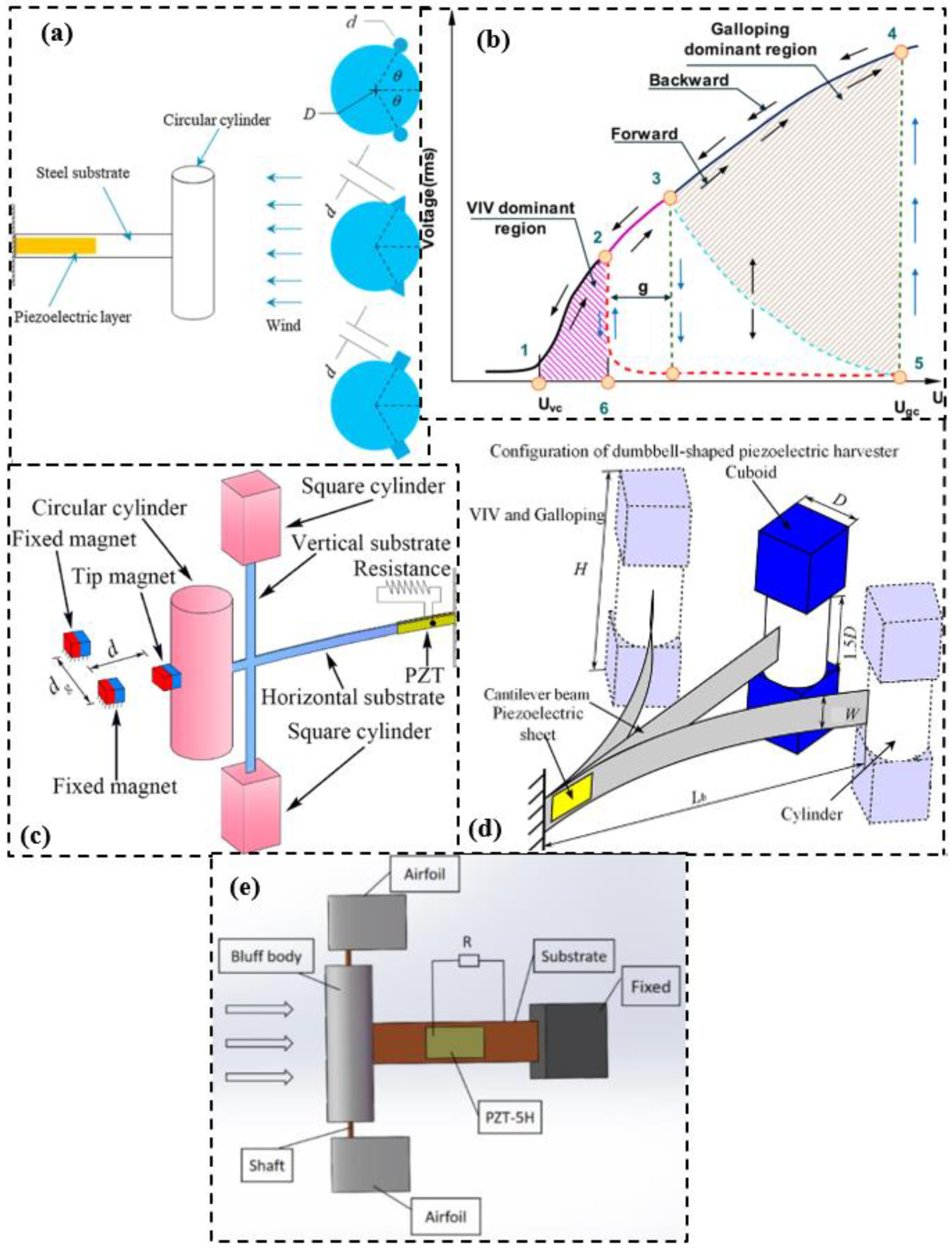
| Coupled Mechanism | Shape of the Bluff Body | Cut-in Velocity (m/s) | Optimum Resistance (kΩ) | Velocity at Max Power (m/s) | Output Power (mW) | References |
|---|---|---|---|---|---|---|
| VIV–Galloping | Diamond-shaped baffle | 200 | 32 | - | Kan et al. [46] | |
| VIV–Galloping | Bulb-shaped | 50 | 2.95 | - | Sun et al. [77] | |
| Galloping–Wake galloping | D-shaped | 2.45 | 410 | 9 | 2.3 | Kim et al. [147] |
| VIV–Galloping | T-shaped | <2 | 1500 | 3 | 0.4 | Petrini et al. [195] |
| VIV–Galloping | Fin-shaped | 200 | 6.8 | 1.645 | Ding et al. [199] | |
| VIV–Wake galloping | Cylindrical- shaped |
|
| 6.5 | 0.00875 | Chen et al. [201] |
| VIV–Galloping | Rectangular with leeward protrusion | 2 | 200 | 5.1 | 0.992 | Xing et al. [200] |
| Flutter–VIV |
| 5.42 | 400 | 14.48 | 0.154 | Shan et al. [202] |
| Flutter–VIV | Cylindrical with two airfoils | 4.8 | 140 | 9 | 6.47 | Li et al. [203] |
| Flutter–VIV | Airfoil | 7.6 | 250 | 14.39 | 5.43 | Wan et al. [204] |
8. Rotary Wind Energy Harvesters
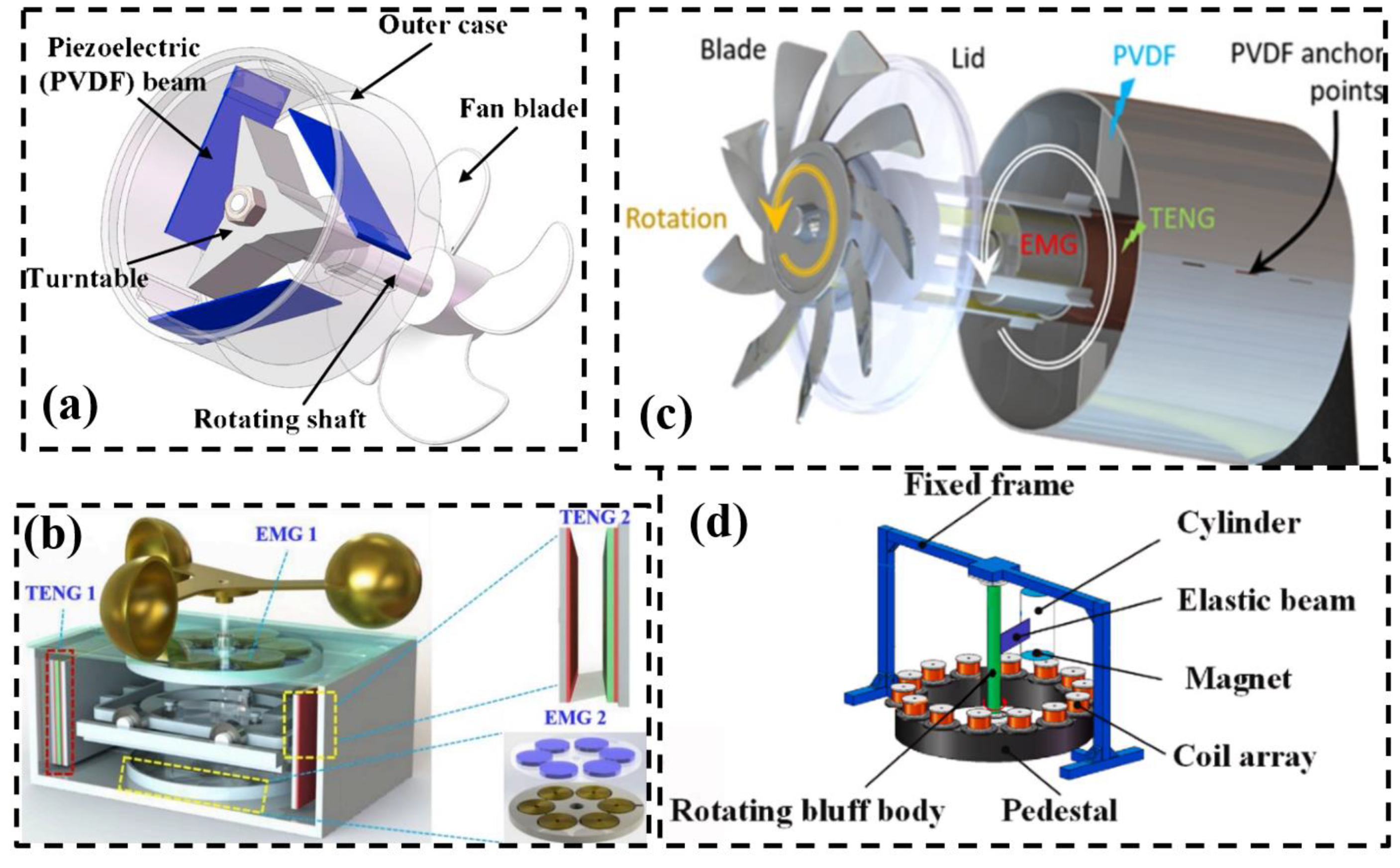
| Transduction Mechanism | Velocity (m/s) | Output Power (mW) | References |
|---|---|---|---|
| Tribo-electromagnetic | 9 | 0.36 (TE) 18.6 (EM) | Fan et al. [207] |
| Piezoelectric-triboelectric-electromagnetic | 3.5 | 0.121 (PE) 0.191 (EM) 0.000168 (TE) | Egbe et al. [209] |
| Piezoelectric | 2 | 1.06 | Narolia et al. [210] |
| 5 | 2.21 | ||
| Tribo-electromagnetic | 15 | 7.54 (Lateral TE) 7.85 (Top TE) 22.5 (EM) | Cao et al. [211] |
| Electromagnetic | 5.22 | 0.498 | Li et al. [212] |
| 8 | 0.673 | ||
| Triboelectric | 12 | 140 mW/m2 | Li et al. [213] |
9. Discussion, Future Prospects and Challenges for FBEHs
10. Conclusions
Author Contributions
Funding
Acknowledgments
Conflicts of Interest
References
- Kuriakose, J.; Amruth, V.; Nandhini, N.S. A survey on localization of Wireless Sensor nodes. In Proceedings of the International Conference on Information Communication and Embedded Systems (ICICES2014), Chennai, India, 27–28 February 2015; pp. 6–11. [Google Scholar] [CrossRef]
- Khalaf, O.I.; Sabbar, B.M. An overview on wireless sensor networks and finding optimal location of nodes. Period. Eng. Nat. Sci. 2019, 7, 1096–1101. [Google Scholar] [CrossRef]
- Xu, C.; Song, Y.; Han, M.; Zhang, H. Portable and wearable self-powered systems based on emerging energy harvesting technology. Microsyst. Nanoeng. 2021, 7, 25. [Google Scholar] [CrossRef] [PubMed]
- Bakhtiar, S.; Ilyas, M.; Khan, F.S.H.; Saadullah, C.; Viqar, M.Z.; Hussain, S.M.Z. Flapping Induced Piezoelectric Transduction for Novel Disaster Management UAVs; Springer Nature: Singapore, 2022; Volume 921. [Google Scholar] [CrossRef]
- Masabi, S.N.; Fu, H.; Theodossiades, S. A bistable rotary-translational energy harvester from ultra-low-frequency motions for self-powered wireless sensing. J. Phys. D Appl. Phys. 2023, 56, 24001. [Google Scholar] [CrossRef]
- Masabi, S.N.; Fu, H.; Flint, J.; Theodossiades, S. A multi-stable rotational energy harvester for arbitrary bi-directional horizontal excitation at ultra-low frequencies for self-powered sensing. Smart Mater. Struct. 2024, 33, 95017. [Google Scholar] [CrossRef]
- Izhar; Khan, F.U. Electromagnetic based acoustic energy harvester for low power wireless autonomous sensor applications. Sens. Rev. 2018, 38, 298–310. [Google Scholar] [CrossRef]
- Zhang, Y.; Xie, M.; Adamaki, V.; Khanbareh, H.; Bowen, C.R. Control of electro-chemical processes using energy harvesting materials and devices. Chem. Soc. Rev. 2017, 46, 7757–7786. [Google Scholar] [CrossRef]
- Tao, J.X.; Viet, N.V.; Carpinteri, A.; Wang, Q. Energy harvesting from wind by a piezoelectric harvester. Eng. Struct. 2017, 133, 74–80. [Google Scholar] [CrossRef]
- Cuadras, A.; Gasulla, M.; Ferrari, V. Thermal energy harvesting through pyroelectricity. Sens. Actuators A Phys. 2010, 158, 132–139. [Google Scholar] [CrossRef]
- Khan, A.S.; Khan, F.U. A Wearable Solar Energy Harvesting Based Jacket With Maximum Power Point Tracking for Vital Health Monitoring Systems. IEEE Access 2022, 10, 119475–119495. [Google Scholar] [CrossRef]
- Kim, M.; Dugundji, J.; Wardle, B.L. Efficiency of piezoelectric mechanical vibration energy harvesting. Smart Mater. Struct. 2015, 24, 055006. [Google Scholar] [CrossRef]
- Bowen, C.R.; Taylor, J.; Leboulbar, E.; Zabek, D.; Chauhan, A.; Vaish, R. Pyroelectric materials and devices for energy harvesting applications. Energy Environ. Sci. 2014, 7, 3836–3856. [Google Scholar] [CrossRef]
- Zou, H.-X.; Zhao, L.-C.; Wang, Q.; Gao, Q.-H.; Yan, G.; Wei, K.-X.; Zhang, W.-M. A self-regulation strategy for triboelectric nanogenerator and self-powered wind-speed sensor. Nano Energy 2022, 95, 106990. [Google Scholar] [CrossRef]
- Wang, J.; Yurchenko, D.; Hu, G.; Zhao, L.; Tang, L.; Yang, Y. Perspectives in flow-induced vibration energy harvesting. Appl. Phys. Lett. 2021, 119, 100502. [Google Scholar] [CrossRef]
- Parameshwaran, R.; Dhulipalla, S.J.; Yendluri, D.R. Fluid-structure Interactions and Flow Induced Vibrations: A Review. Procedia Eng. 2016, 144, 1286–1293. [Google Scholar] [CrossRef]
- Nishi, Y.; Fukuda, K.; Shinohara, W. Experimental energy harvesting from fluid flow by using two vibrating masses. J. Sound Vib. 2017, 394, 321–332. [Google Scholar] [CrossRef]
- Zou, H.X.; Li, M.; Zhao, L.C.; Gao, Q.H.; Wei, K.X.; Zuo, L.; Qian, F.; Zhang, W.M. A magnetically coupled bistable piezoelectric harvester for underwater energy harvesting. Energy 2021, 217, 119429. [Google Scholar] [CrossRef]
- Mehmood, A.; Abdelkefi, A.; Hajj, M.R.; Nayfeh, A.H.; Akhtar, I.; Nuhait, A.O. Piezoelectric energy harvesting from vortex-induced vibrations of circular cylinder. J. Sound Vib. 2013, 332, 4656–4667. [Google Scholar] [CrossRef]
- McCarthy, J.M.; Watkins, S.; Deivasigamani, A.; John, S.J. Fluttering energy harvesters in the wind: A review. J. Sound Vib. 2016, 361, 355–377. [Google Scholar] [CrossRef]
- Yan, Z.; Abdelkefi, A.; Hajj, M.R. Piezoelectric energy harvesting from hybrid vibrations. Smart Mater. Struct. 2014, 23, 025026. [Google Scholar] [CrossRef]
- Abdelkefi, A.; Scanlon, J.M.; McDowell, E.; Hajj, M.R. Performance enhancement of piezoelectric energy harvesters from wake galloping. Appl. Phys. Lett. 2013, 103, 033903. [Google Scholar] [CrossRef]
- Hobeck, J.D.; Inman, D.J. Energy Harvesting From Turbulence-Induced Vibration in Air Flow: Artificial Piezoelectric Grass Concept. In Proceedings of the ASME 2011 Conference on Smart Materials, Adaptive Structures and Intelligent Systems, Scottsdale, AZ, USA, 18–21 September 2011; pp. 637–646. [Google Scholar] [CrossRef]
- Bakhtiar, S.; Khan, F.U.; Rahman, W.U.; Khan, A.S.; Ahmad, M.M.; Iqbal, M. A Pressure-Based Electromagnetic Energy Harvester for Pipeline Monitoring Applications. J. Sens. 2022, 2022, 6529623. [Google Scholar] [CrossRef]
- Bakhtiar, S.; Hajjaj, A.Z.; Fu, H.; Theodossiades, S. A Two-Body Low-Frequency Piezoelectric Wind Energy Harvester for Environmental Sensing. In Proceedings of the IEMTRONICS 2024, International IOT, Electronics and Mechatronics Conference, London, UK, 3–5 April 2024; pp. 5–11. [Google Scholar]
- Barrero-Gil, A.; Alonso, G.; Sanz-Andres, A. Energy harvesting from transverse galloping. J. Sound Vib. 2010, 329, 2873–2883. [Google Scholar] [CrossRef]
- Khan, F.U.; Ahmad, S. Flow type electromagnetic based energy harvester for pipeline health monitoring system. Energy Convers. Manag. 2019, 200, 112089. [Google Scholar] [CrossRef]
- Bakhtiar, S.; Khan, F.U. Energy harvesting from pulsating fluid flow for pipeline monitoring systems. In Proceedings of the 2019 International Symposium on Recent Advances in Electrical Engineering (RAEE), Islamabad, Pakistan, 28–29 August 2019; Volume 4, pp. 1–6. [Google Scholar] [CrossRef]
- Lee, G.; Lee, D.; Park, J.; Jang, Y.; Kim, M.; Rho, J. Piezoelectric energy harvesting using mechanical metamaterials and phononic crystals. Commun. Phys. 2022, 5, 94. [Google Scholar] [CrossRef]
- Zargari, S.; Daie Koozehkanani, Z.; Veladi, H.; Sobhi, J.; Rezania, A. A new Mylar-based triboelectric energy harvester with an innovative design for mechanical energy harvesting applications. Energy Convers. Manag. 2021, 244, 114489. [Google Scholar] [CrossRef]
- Hou, C.; Li, C.; Shan, X.; Yang, C.; Song, R.; Xie, T. A broadband piezo-electromagnetic hybrid energy harvester under combined vortex-induced and base excitations. Mech. Syst. Signal Process. 2022, 171, 108963. [Google Scholar] [CrossRef]
- Anton, S.R.; Sodano, H.A. A review of power harvesting using piezoelectric materials (2003–2006). Smart Mater. Struct. 2007, 16, R1. [Google Scholar] [CrossRef]
- Ng, T.H.; Liao, W.H. Sensitivity analysis and energy harvesting for a self-powered piezoelectric sensor. J. Intell. Mater. Syst. Struct. 2005, 16, 785–797. [Google Scholar] [CrossRef]
- Yang, B.; Lee, C.; Xiang, W.; Xie, J.; He, J.H.; Kotlanka, R.K.; Low, S.P.; Feng, H. Electromagnetic energy harvesting from vibrations of multiple frequencies. J. Micromech. Microeng. 2009, 19, 35001. [Google Scholar] [CrossRef]
- Li, P.; Wen, Y.; Liu, P.; Li, X.; Jia, C. A magnetoelectric energy harvester and management circuit for wireless sensor network. Sens. Actuators A Phys. 2010, 157, 100–106. [Google Scholar] [CrossRef]
- Foisal, A.R.M.; Hong, C.; Chung, G.S. Multi-frequency electromagnetic energy harvester using a magnetic spring cantilever. Sens. Actuators A Phys. 2012, 182, 106–113. [Google Scholar] [CrossRef]
- Lin, Z.; Chen, J.; Yang, J. Recent Progress in Triboelectric Nanogenerators as a Renewable and Sustainable Power Source. J. Nanomater. 2016, 2016, 5651613. [Google Scholar] [CrossRef]
- Zou, Y.; Raveendran, V.; Chen, J. Wearable triboelectric nanogenerators for biomechanical energy harvesting. Nano Energy 2020, 77, 105303. [Google Scholar] [CrossRef]
- Wang, D.-A.; Pham, H.-T.; Chao, C.-W.; Chen, J.M. A Piezoelectric Energy Harvester Based on Pressure Fluctuations in Karman Vortex Street. In Proceedings of the World Renewable Energy Congress, Sweden, Linköping, Sweden, 8–13 May 2011; Volume 57, pp. 1456–1463. [Google Scholar] [CrossRef]
- Païdoussis, M.P.; Price, S.J.; De Langre, E. Fluid-Structure Interactions: Cross-Flow-Induced Instabilities; Cambridge University Press: Cambridge, UK, 2011. [Google Scholar]
- Akaydin, H.D.; Elvin, N.; Andreopoulos, Y. Energy harvesting from highly unsteady fluid flows using piezoelectric materials. J. Intell. Mater. Syst. Struct. 2010, 21, 1263–1278. [Google Scholar] [CrossRef]
- Song, R.; Shan, X.; Lv, F.; Xie, T. A study of vortex-induced energy harvesting from water using PZT piezoelectric cantilever with cylindrical extension. Ceram. Int. 2015, 41, S768–S773. [Google Scholar] [CrossRef]
- Demori, M.; Ferrari, M.; Bonzanini, A.; Poesio, P.; Ferrari, V. Autonomous sensors powered by energy harvesting from von Karman vortices in airflow. Sensors 2017, 17, 2100. [Google Scholar] [CrossRef]
- Thein, C.K.; Liu, J.-S. Numerical modeling of shape and topology optimisation of a piezoelectric cantilever beam in an energy-harvesting sensor. Eng. Comput. 2017, 33, 137–148. [Google Scholar] [CrossRef]
- Ding, L.; Zhang, L.; Wu, C.; Mao, X.; Jiang, D. Flow induced motion and energy harvesting of bluff bodies with different cross sections. Energy Convers. Manag. 2015, 91, 416–426. [Google Scholar] [CrossRef]
- Kan, J.; Liao, W.; Wang, J.; Wang, S.; Yan, M.; Jiang, Y.; Zhang, Z. Enhanced piezoelectric wind-induced vibration energy harvester via the interplay between cylindrical shell and diamond-shaped baffle. Nano Energy 2021, 89, 106466. [Google Scholar] [CrossRef]
- Gong, Y.; Shan, X.; Luo, X.; Pan, J.; Xie, T.; Yang, Z. Direction-adaptive energy harvesting with a guide wing under flow-induced oscillations. Energy 2019, 187, 115983. [Google Scholar] [CrossRef]
- Hu, Y.; Yang, B.; Chen, X.; Wang, X.; Liu, J. Modeling and experimental study of a piezoelectric energy harvester from vortex shedding-induced vibration. Energy Convers. Manag. 2018, 162, 145–158. [Google Scholar] [CrossRef]
- Du, X.; Zhang, M.; Chang, H.; Wang, Y.; Yu, H. Micro windmill piezoelectric energy harvester based on vortex-induced vibration in tunnel. Energy 2022, 238, 121734. [Google Scholar] [CrossRef]
- Zuo, L.; Tang, X. Large-scale vibration energy harvesting. J. Intell. Mater. Syst. Struct. 2013, 24, 1405–1430. [Google Scholar] [CrossRef]
- Gong, Y.; Yang, Z.; Shan, X.; Sun, Y.; Xie, T.; Zi, Y. Capturing Flow Energy from Ocean and Wind. Energies 2019, 12, 2184. [Google Scholar] [CrossRef]
- Xie, X.D.; Wang, Q.; Wu, N. Energy harvesting from transverse ocean waves by a piezoelectric plate. Int. J. Eng. Sci. 2014, 81, 41–48. [Google Scholar] [CrossRef]
- Dai, H.L.; Abdelkefi, A.; Yang, Y.; Wang, L. Orientation of bluff body for designing efficient energy harvesters from vortex-induced vibrations. Appl. Phys. Lett. 2016, 108, 53902. [Google Scholar] [CrossRef]
- Zhou, G.; Li, Z.; Zhu, Z.; Hao, B.; Tang, C. A New Piezoelectric Bimorph Energy Harvester Based on the Vortex-Induced-Vibration Applied in Rotational Machinery. IEEE/ASME Trans. Mechatron. 2019, 24, 700–709. [Google Scholar] [CrossRef]
- Wang, M.; Wang, W.; Li, Q. Structural optimization of laminated leaf-like piezoelectric wind energy harvesters based on topological method. Adv. Mech. Eng. 2024, 16, 16878132231224577. [Google Scholar] [CrossRef]
- Wang, D.-A.; Chang, K.-H. Electromagnetic energy harvesting from flow induced vibration. Microelectron. J. 2010, 41, 356–364. [Google Scholar] [CrossRef]
- Wang, D.A.; Chiu, C.Y.; Pham, H.T. Electromagnetic energy harvesting from vibrations induced by Kármán vortex street. Mechatronics 2012, 22, 746–756. [Google Scholar] [CrossRef]
- Sarviha, A.; Barati, E.; Zarkak, M.R.; Derakhshandeh, J.F.; Alam, M.M. Experimental Investigations on the Wake-Induced Vibration of an Electromagnetic Energy-Harvesting System. Int. J. Energy Res. 2024, 2024, 7072340. [Google Scholar] [CrossRef]
- Zhang, L.; Meng, B.; Tian, Y.; Meng, X.; Lin, X.; He, Y.; Xing, C.; Dai, H.; Wang, L. Vortex-induced vibration triboelectric nanogenerator for low speed wind energy harvesting. Nano Energy 2022, 95, 107029. [Google Scholar] [CrossRef]
- Wang, Y.; Chen, T.; Sun, S.; Liu, X.; Hu, Z.; Lian, Z.; Liu, L.; Shi, Q.; Wang, H.; Mi, J.; et al. A humidity resistant and high performance triboelectric nanogenerator enabled by vortex-induced vibration for scavenging wind energy. Nano Res. 2022, 15, 3246–3253. [Google Scholar] [CrossRef]
- Li, X.; Zhou, Y.; Li, Z.; Guo, H.; Gong, Y.; Zhang, D.; Zhang, D.; Zhang, Q.; Wang, B.; Peng, Y. Vortex-induced vibration triboelectric nanogenerator for energy harvesting from low-frequency water flow. Energy Convers. Manag. 2023, 292, 117383. [Google Scholar] [CrossRef]
- Han, Y.; Wu, F.; Du, X.; Li, Z.; Chen, H.; Guo, D.; Wang, J.; Yu, H. Enhance vortices vibration with Y-type bluff body to decrease arousing wind speed and extend range for flag triboelectric energy harvester. Nano Energy 2024, 119, 109063. [Google Scholar] [CrossRef]
- Choi, J.-A.; Jeong, J.; Kang, M.; Ko, H.-J.; Kim, T.; Park, K.; Kim, J.; Pyo, S. Externally motionless triboelectric nanogenerator based on vortex-induced rolling for omnidirectional wind energy harvesting. Nano Energy 2024, 119, 109071. [Google Scholar] [CrossRef]
- Bashir, M.; Rajendran, P.; Khan, S.A. Energy Harvesting from Aerodynamic Instabilities: Current prospect and Future Trends. IOP Conf. Ser. Mater. Sci. Eng. 2018, 290, 012054. [Google Scholar] [CrossRef]
- Yang, Y.; Zhao, L.; Tang, L. Comparative study of tip cross-sections for efficient galloping energy harvesting. Appl. Phys. Lett. 2013, 102, 064105. [Google Scholar] [CrossRef]
- Sirohi, J.; Mahadik, R. Piezoelectric wind energy harvester for low-power sensors. J. Intell. Mater. Syst. Struct. 2011, 22, 2215–2228. [Google Scholar] [CrossRef]
- Sirohi, J.; Mahadik, R. Harvesting wind energy using a galloping piezoelectric beam. J. Vib. Acoust. Trans. ASME 2012, 134, 011009. [Google Scholar] [CrossRef]
- Abdelkefi, A.; Hajj, M.R.; Nayfeh, A.H. Piezoelectric energy harvesting from transverse galloping of bluff bodies. Smart Mater. Struct. 2013, 22, 015014. [Google Scholar] [CrossRef]
- Zhao, L.; Tang, L.; Yang, Y. Comparison of modeling methods and parametric study for a piezoelectric wind energy harvester. Smart Mater. Struct. 2013, 22, 125003. [Google Scholar] [CrossRef]
- Hémon, P.; Amandolese, X.; Andrianne, T. Energy harvesting from galloping of prisms: A wind tunnel experiment. J. Fluids Struct. 2017, 70, 390–402. [Google Scholar] [CrossRef]
- Bibo, A.; Daqaq, M.F. On the optimal performance and universal design curves of galloping energy harvesters. Appl. Phys. Lett. 2014, 104, 023901. [Google Scholar] [CrossRef]
- Hu, G.; Tse, K.T.; Kwok, K.C.S.; Song, J.; Lyu, Y. Aerodynamic modification to a circular cylinder to enhance the piezoelectric wind energy harvesting. Appl. Phys. Lett. 2016, 109, 193902. [Google Scholar] [CrossRef]
- Hu, G.; Tse, K.T.; Kwok, K.C.S. Enhanced performance of wind energy harvester by aerodynamic treatment of a square prism. Appl. Phys. Lett. 2016, 108, 123901. [Google Scholar] [CrossRef]
- Liu, F.R.; Zou, H.X.; Zhang, W.M.; Peng, Z.K.; Meng, G. Y-type three-blade bluff body for wind energy harvesting. Appl. Phys. Lett. 2018, 112, 233903. [Google Scholar] [CrossRef]
- Liu, F.R.; Zhang, W.M.; Peng, Z.K.; Meng, G. Fork-shaped bluff body for enhancing the performance of galloping-based wind energy harvester. Energy 2019, 183, 92–105. [Google Scholar] [CrossRef]
- Wang, J.; Zhou, S.; Zhang, Z.; Yurchenko, D. High-performance piezoelectric wind energy harvester with Y-shaped attachments. Energy Convers. Manag. 2019, 181, 645–652. [Google Scholar] [CrossRef]
- Sun, W.; Jo, S.; Seok, J. Development of the optimal bluff body for wind energy harvesting using the synergetic effect of coupled vortex induced vibration and galloping phenomena. Int. J. Mech. Sci. 2019, 156, 435–445. [Google Scholar] [CrossRef]
- Zhou, C.F.; Zou, H.X.; Wei, K.X.; Liu, J.G. Enhanced performance of piezoelectric wind energy harvester by a curved plate. Smart Mater. Struct. 2019, 28, 125022. [Google Scholar] [CrossRef]
- Tucker Harvey, S.; Khovanov, I.A.; Denissenko, P. A galloping energy harvester with flow attachment. Appl. Phys. Lett. 2019, 114, 104103. [Google Scholar] [CrossRef]
- Noel, J.; Yadav, R.; Li, G.; Daqaq, M.F. Improving the performance of galloping micro-power generators by passively manipulating the trailing edge. Appl. Phys. Lett. 2018, 112, 83503. [Google Scholar] [CrossRef]
- Jo, S.; Sun, W.; Son, C.; Seok, J. Galloping-based energy harvester considering enclosure effect. AIP Adv. 2018, 8, 095309. [Google Scholar] [CrossRef]
- Zhao, K.; Zhang, Q.; Wang, W. Optimization of galloping piezoelectric energy harvester with V-shaped groove in low wind speed. Energies 2019, 12, 4619. [Google Scholar] [CrossRef]
- Siriyothai, P.; Kittichaikarn, C. Performance enhancement of a galloping-based energy harvester with different groove depths on square bluff body. Renew. Energy 2023, 210, 148–158. [Google Scholar] [CrossRef]
- Wang, W.; Huang, J.; Yao, Z. Cut-corner prism piezoelectric energy harvester based on galloping enhancement mechanism. Energy Rep. 2021, 7, 6366–6374. [Google Scholar] [CrossRef]
- Zhao, D.; Hu, X.; Tan, T.; Yan, Z.; Zhang, W. Piezoelectric galloping energy harvesting enhanced by topological equivalent aerodynamic design. Energy Convers. Manag. 2020, 222, 113260. [Google Scholar] [CrossRef]
- Yuan, Y.; Wang, H.; Yang, C.; Sun, H.; Tang, Y.; Zhang, Z. Exploring the Potential of Flow-Induced Vibration Energy Harvesting Using a Corrugated Hyperstructure Bluff Body. Micromachines 2023, 14, 1125. [Google Scholar] [CrossRef]
- Wang, J.; Kan, J.; Gu, Y.; He, C.; Ren, Z.; Meng, F.; Wang, S.; Zhang, Z. Design, performance evaluation and calibration of an indirectly-excited piezoelectric wind energy harvester via a double-bluffbody exciter. Energy Convers. Manag. 2023, 284, 116969. [Google Scholar] [CrossRef]
- Liu, J.; Bao, B.; Chen, J.; Wu, Y.; Wang, Q. Passively adaptive wind energy harvester featuring a double-airfoil bluff body with adjustable attack angles. Mech. Syst. Signal Process. 2023, 185, 109814. [Google Scholar] [CrossRef]
- Tan, T.; Zuo, L.; Yan, Z. Environment coupled piezoelectric galloping wind energy harvesting. Sens. Actuators A Phys. 2021, 323, 112641. [Google Scholar] [CrossRef]
- Hu, S.; Zhao, D.; Sun, W.; Liu, Y.; Ma, C. Investigation on galloping piezoelectric energy harvester considering the surface roughness in low velocity water flow. Energy 2023, 262, 125478. [Google Scholar] [CrossRef]
- Xia, C.; Yang, J.; Tang, L.; Yin, P.; Li, Z.; Wang, B.; Aw, K.C. A multi-directional and multi-modal galloping piezoelectric energy harvester with tri-section beam. Smart Mater. Struct. 2024, 33, 035045. [Google Scholar] [CrossRef]
- Ali, M.; Arafa, M.; Elaraby, M. Harvesting energy from galloping oscillations. Lect. Notes Eng. Comput. Sci. 2013, 3, 2053–2058. [Google Scholar]
- Zhang, L.B.; Dai, H.L.; Abdelkefi, A.; Lin, S.X.; Wang, L. Theoretical modeling, wind tunnel measurements, and realistic environment testing of galloping-based electromagnetic energy harvesters. Appl. Energy 2019, 254, 113737. [Google Scholar] [CrossRef]
- Xiong, L.; Gao, S.; Jin, L.; Guo, S.; Sun, Y.; Liu, F. The Design and Experiment of a Spring-Coupling Electromagnetic Galloping Energy Harvester. Micromachines 2023, 14, 968. [Google Scholar] [CrossRef]
- Kim, H.; Kim, S.; Xue, K.; Seok, J. Modeling and performance analysis of electromagnetic energy harvester based on torsional galloping phenomenon. Mech. Syst. Signal Process. 2023, 195, 110287. [Google Scholar] [CrossRef]
- Su, B.; Wang, Y.; Li, J.; Guo, T.; Cheng, G.; Sun, W. A novel elastic strip suspension-based bi-directional electromagnetic wind energy harvester designed specifically for wind energy factories. Mech. Syst. Signal Process. 2024, 208, 111059. [Google Scholar] [CrossRef]
- Zhang, L.; Meng, B.; Xia, Y.; Deng, Z.; Dai, H.; Hagedorn, P.; Peng, Z.; Wang, L. Galloping triboelectric nanogenerator for energy harvesting under low wind speed. Nano Energy 2020, 70, 104477. [Google Scholar] [CrossRef]
- Zeng, Q.; Wu, Y.; Tang, Q.; Liu, W.; Wu, J.; Zhang, Y.; Yin, G.; Yang, H.; Yuan, S.; Tan, D.; et al. A high-efficient breeze energy harvester utilizing a full-packaged triboelectric nanogenerator based on flow-induced vibration. Nano Energy 2020, 70, 104524. [Google Scholar] [CrossRef]
- Zhang, S.; Jing, Z.; Wang, X.; Zhu, M.; Yu, X.; Zhu, J.; Cheng, T.; Zhao, H.; Wang, Z.L. Soft-bionic-fishtail structured triboelectric nanogenerator driven by flow-induced vibration for low-velocity water flow energy harvesting. Nano Res. 2023, 16, 466–472. [Google Scholar] [CrossRef]
- Cao, L.N.Y.; Su, E.; Xu, Z.; Wang, Z.L. Fully enclosed microbeads structured TENG arrays for omnidirectional wind energy harvesting with a portable galloping oscillator. Mater. Today 2023, 71, 9–21. [Google Scholar] [CrossRef]
- Ma, X.; Zhou, S. A review of flow-induced vibration energy harvesters. Energy Convers. Manag. 2022, 254, 115223. [Google Scholar] [CrossRef]
- Wen, Q.; He, X.; Lu, Z.; Streiter, R.; Otto, T. A comprehensive review of miniatured wind energy harvesters. Nano Mater. Sci. 2021, 3, 170–185. [Google Scholar] [CrossRef]
- Ravi, S.; Zilian, A. Simultaneous finite element analysis of circuit-integrated piezoelectric energy harvesting from fluid-structure interaction. Mech. Syst. Signal Process. 2019, 114, 259–274. [Google Scholar] [CrossRef]
- Erturk, A.; Bilgen, O.; Fontenille, M.; Inman, D.J. Piezoelectric energy harvesting from macro-fiber composites with an application to morphing-wing aircrafts. In Proceedings of the 19th International Conference on Adaptive Structures and Technologies 2008 (ICAST 2008), Ascona, Switzerland, 6–9 October 2008; pp. 339–359. [Google Scholar]
- Erturk, A.; Vieira, W.G.R.; De Marqui, C.; Inman, D.J. On the energy harvesting potential of piezoaeroelastic systems. Appl. Phys. Lett. 2010, 96, 184103. [Google Scholar] [CrossRef]
- Bryant, M.; Garcia, E. Modeling and Testing of a Novel Aeroelastic Flutter Energy Harvester. J. Vib. Acoust. 2011, 133, 011010. [Google Scholar] [CrossRef]
- Kwon, S.D. A T-shaped piezoelectric cantilever for fluid energy harvesting. Appl. Phys. Lett. 2010, 97, 164102. [Google Scholar] [CrossRef]
- Bibo, A.; Daqaq, M.F. Investigation of concurrent energy harvesting from ambient vibrations and wind using a single piezoelectric generator. Appl. Phys. Lett. 2013, 102, 243904. [Google Scholar] [CrossRef]
- Zakaria, M.Y.; Al-Haik, M.Y.; Hajj, M.R. Experimental analysis of energy harvesting from self-induced flutter of a composite beam. Appl. Phys. Lett. 2015, 107, 2–6. [Google Scholar] [CrossRef]
- Eugeni, M.; Elahi, H.; Fune, F.; Lampani, L.; Mastroddi, F.; Romano, G.P.; Gaudenzi, P. Numerical and experimental investigation of piezoelectric energy harvester based on flag-flutter. Aerosp. Sci. Technol. 2020, 97, 105634. [Google Scholar] [CrossRef]
- Agarwal, A.; Purohit, A. On the performance improvement of a flutter based energy harvester by introducing additional wake field. In Energy Sources, Part A: Recovery, Utilization, and Environmental Effects; Taylor & Francis: Oxfordshire, UK, 2021; pp. 1–14. [Google Scholar] [CrossRef]
- Latif, U.; Dowell, E.H.; Uddin, E.; Yamin Younis, M. Parametric aerodynamic and aeroelastic study of a deformable flag-based energy harvester for powering low energy devices. Energy Convers. Manag. 2023, 280, 116846. [Google Scholar] [CrossRef]
- Zhu, D.; Beeby, S.; Tudor, J.; White, N.; Harris, N. A novel miniature wind generator for wireless sensing applications. Proc. IEEE Sens. 2010, 1, 1415–1418. [Google Scholar] [CrossRef]
- Park, J.; Morgenthal, G.; Kim, K.; Kwon, S.D.; Law, K.H. Power evaluation of flutter-based electromagnetic energy harvesters using computational fluid dynamics simulations. J. Intell. Mater. Syst. Struct. 2014, 25, 1800–1812. [Google Scholar] [CrossRef]
- Dinh Quy, V.; Van Sy, N.; Tan Hung, D.; Quoc Huy, V. Wind tunnel and initial field tests of a micro generator powered by fluid-induced flutter. Energy Sustain. Dev. 2016, 33, 75–83. [Google Scholar] [CrossRef]
- Atrah, A.B.; Ab-Rahman, M.S.; Salleh, H.; Nuawi, M.Z.; Mohd Nor, M.J.; Jamaludin, N. Bin Karman Vortex Creation Using Cylinder for Flutter Energy Harvester Device. Micromachines 2017, 8, 227. [Google Scholar] [CrossRef]
- Lu, Z.; Wen, Q.; He, X.; Wen, Z. A Flutter-Based Electromagnetic Wind Energy Harvester: Theory and Experiments. Appl. Sci. 2019, 9, 4823. [Google Scholar] [CrossRef]
- Nabavi, S.; Zhang, L. Portable wind energy harvesters for low-power applications: A survey. Sensors 2016, 16, 1101. [Google Scholar] [CrossRef]
- Zhao, Z.; Pu, X.; Du, C.; Li, L.; Jiang, C.; Hu, W.; Wang, Z.L. Freestanding Flag-Type Triboelectric Nanogenerator for Harvesting High-Altitude Wind Energy from Arbitrary Directions. ACS Nano 2016, 10, 1780–1787. [Google Scholar] [CrossRef]
- Phan, H.; Shin, D.-M.; Heon Jeon, S.; Young Kang, T.; Han, P.; Han Kim, G.; Kook Kim, H.; Kim, K.; Hwang, Y.-H.; Won Hong, S. Aerodynamic and aeroelastic flutters driven triboelectric nanogenerators for harvesting broadband airflow energy. Nano Energy 2017, 33, 476–484. [Google Scholar] [CrossRef]
- Liu, X.; Zhao, K.; Yang, Y. Effective polarization of ferroelectric materials by using a triboelectric nanogenerator to scavenge wind energy. Nano Energy 2018, 53, 622–629. [Google Scholar] [CrossRef]
- Lin, H.; He, M.; Jing, Q.; Yang, W.; Wang, S.; Liu, Y.; Zhang, Y.; Li, J.; Li, N.; Ma, Y.; et al. Angle-shaped triboelectric nanogenerator for harvesting environmental wind energy. Nano Energy 2019, 56, 269–276. [Google Scholar] [CrossRef]
- Feng, Y.; Zhang, L.; Zheng, Y.; Wang, D.; Zhou, F.; Liu, W. Leaves based triboelectric nanogenerator (TENG) and TENG tree for wind energy harvesting. Nano Energy 2019, 55, 260–268. [Google Scholar] [CrossRef]
- Ravichandran, A.N.; Calmes, C.; Serres, J.R.; Ramuz, M.; Blayac, S. Compact and high performance wind actuated venturi triboelectric energy harvester. Nano Energy 2019, 62, 449–457. [Google Scholar] [CrossRef]
- Wang, Y.; Yang, E.; Chen, T.; Wang, J.; Hu, Z.; Mi, J.; Pan, X.; Xu, M. A novel humidity resisting and wind direction adapting flag-type triboelectric nanogenerator for wind energy harvesting and speed sensing. Nano Energy 2020, 78, 105279. [Google Scholar] [CrossRef]
- Gao, S.; Zeng, X.; Chen, X.; Liao, T.; Wang, R.; Chen, Y.; Wei, H.; Luo, X.; Feng, S. Self-powered system for environment and aeolian vibration monitoring in the high-voltage transmission system by multi-directional wind-driven triboelectric nanogenerator. Nano Energy 2023, 117, 108911. [Google Scholar] [CrossRef]
- Tadrist, L.; Julio, K.; Saudreau, M.; de Langre, E. Leaf flutter by torsional galloping: Experiments and model. J. Fluids Struct. 2015, 56, 1–10. [Google Scholar] [CrossRef]
- Li, S.; Yuan, J.; Lipson, H. Ambient wind energy harvesting using cross-flow fluttering. J. Appl. Phys. 2011, 109, 26104. [Google Scholar] [CrossRef]
- Hobbs, W.B.; Hu, D.L. Tree-inspired piezoelectric energy harvesting. J. Fluids Struct. 2012, 28, 103–114. [Google Scholar] [CrossRef]
- Ahmed, A.; Hassan, I.; Song, P.; Gamaleldin, M.; Radhi, A.; Panwar, N.; Tjin, S.C.; Desoky, A.Y.; Sinton, D.; Yong, K.-T.; et al. Self-adaptive Bioinspired Hummingbird-wing Stimulated Triboelectric Nanogenerators. Sci. Rep. 2017, 7, 17143. [Google Scholar] [CrossRef] [PubMed]
- Bo, F.; Jiwen, F.; Jiuchun, Z.; Chong, L.; Jia, W.; Mingming, L. Bionic flutter wing piezoelectric-electromagnetic composite energy harvesting system. Energy Convers. Manag. 2022, 271, 116319. [Google Scholar] [CrossRef]
- Al-Haik, M.Y.; Kabir, M.M.; Siddique, W.; AlNuaimi, S.; Aldajah, S. An experimental study on piezoelectric energy harvesting from palm tree induced by wind. Eng. Res. Express 2020, 2, 25044. [Google Scholar] [CrossRef]
- Liu, J.; Zuo, H.; Xia, W.; Luo, Y.; Yao, D.; Chen, Y.; Wang, K.; Li, Q. Wind energy harvesting using piezoelectric macro fiber composites based on flutter mode. Microelectron. Eng. 2020, 231, 111333. [Google Scholar] [CrossRef]
- Wang, K.; Xia, W.; Lin, T.; Wu, J.; Hu, S. Low-speed flutter of artificial stalk-leaf and its application in wind energy harvesting. Smart Mater. Struct. 2021, 30, 125002. [Google Scholar] [CrossRef]
- Wang, K.; Xia, W.; Ren, J.; Yu, W.; Feng, H.; Hu, S. Wind energy harvesting inspired by Palm leaf flutter: Observation, mechanism and experiment. Energy Convers. Manag. 2023, 284, 116971. [Google Scholar] [CrossRef]
- Alhadidi, A.H.; Abderrahmane, H.; Daqaq, M.F. Exploiting stiffness nonlinearities to improve flow energy capture from the wake of a bluff body. Phys. D Nonlinear Phenom. 2016, 337, 30–42. [Google Scholar] [CrossRef]
- Zhang, B.; Song, B.; Mao, Z.; Tian, W.; Li, B. Numerical investigation on VIV energy harvesting of bluff bodies with different cross sections in tandem arrangement. Energy 2017, 133, 723–736. [Google Scholar] [CrossRef]
- Sun, H.; Ma, C.; Kim, E.S.; Nowakowski, G.; Mauer, E.; Bernitsas, M.M. Hydrokinetic energy conversion by two rough tandem-cylinders in flow induced motions: Effect of spacing and stiffness. Renew. Energy 2017, 107, 61–80. [Google Scholar] [CrossRef]
- Usman, M.; Hanif, A.; Kim, I.H.; Jung, H.J. Experimental validation of a novel piezoelectric energy harvesting system employing wake galloping phenomenon for a broad wind spectrum. Energy 2018, 153, 882–889. [Google Scholar] [CrossRef]
- AkaydIn, H.D.; Elvin, N.; Andreopoulos, Y. Wake of a cylinder: A paradigm for energy harvesting with piezoelectric materials. Exp. Fluids 2010, 49, 291–304. [Google Scholar] [CrossRef]
- Jung, H.J.; Lee, S.W. The experimental validation of a new energy harvesting system based on the wake galloping phenomenon. Smart Mater. Struct. 2011, 20, 055022. [Google Scholar] [CrossRef]
- Sivadas, V.; Wickenheiser, A.M. A study of several vortex-induced vibration techniques for piezoelectric wind energy harvesting. Act. Passiv. Smart Struct. Integr. Syst. 2011, 7977, 79770F. [Google Scholar] [CrossRef]
- Uttayopas, P.; Kittichaikarn, C. Effects of downstream structures on aero elastic energy harvesters from wake-induced vibration. J. Fluids Eng. Trans. ASME 2019, 141, 071103. [Google Scholar] [CrossRef]
- Zhang, L.B.; Dai, H.L.; Abdelkefi, A.; Wang, L. Experimental investigation of aerodynamic energy harvester with different interference cylinder cross-sections. Energy 2019, 167, 970–981. [Google Scholar] [CrossRef]
- Shan, X.; Li, H.; Yang, Y.; Feng, J.; Wang, Y.; Xie, T. Enhancing the performance of an underwater piezoelectric energy harvester based on flow-induced vibration. Energy 2019, 172, 134–140. [Google Scholar] [CrossRef]
- Yan, Z.; Wang, L.; Hajj, M.R.; Yan, Z.; Sun, Y.; Tan, T. Energy harvesting from iced-conductor inspired wake galloping. Extrem. Mech. Lett. 2020, 35, 100633. [Google Scholar] [CrossRef]
- Kim, H.; Lee, J.; Seok, J. Novel piezoelectric wind energy harvester based on coupled galloping phenomena with characterization and quantification of its dynamic behavior. Energy Convers. Manag. 2022, 266, 115849. [Google Scholar] [CrossRef]
- Yuan, S.; Zeng, Q.; Tan, D.; Luo, Y.; Zhang, X.; Guo, H.; Wang, X.; Wang, Z.L. Scavenging breeze wind energy (1–8.1 ms−1) by minimalist triboelectric nanogenerator based on the wake galloping phenomenon. Nano Energy 2022, 100, 107465. [Google Scholar] [CrossRef]
- Wang, J.; Geng, L.; Ding, L.; Zhu, H.; Yurchenko, D. The state-of-the-art review on energy harvesting from flow-induced vibrations. Appl. Energy 2020, 267, 114902. [Google Scholar] [CrossRef]
- Mackowski, A.W.; Williamson, C.H.K. An experimental investigation of vortex-induced vibration with nonlinear restoring forces. Phys. Fluids 2013, 25, 087101. [Google Scholar] [CrossRef]
- Dai, H.L.; Abdelkefi, A.; Wang, L. Theoretical modeling and nonlinear analysis of piezoelectric energy harvesting from vortex-induced vibrations. J. Intell. Mater. Syst. Struct. 2014, 25, 1861–1874. [Google Scholar] [CrossRef]
- Zhang, J.; Zhang, J.; Shu, C.; Fang, Z. Enhanced piezoelectric wind energy harvesting based on a buckled beam. Appl. Phys. Lett. 2017, 110, 183903. [Google Scholar] [CrossRef]
- Naseer, R.; Dai, H.L.; Abdelkefi, A.; Wang, L. Piezomagnetoelastic energy harvesting from vortex-induced vibrations using monostable characteristics. Appl. Energy 2017, 203, 142–153. [Google Scholar] [CrossRef]
- Zhang, L.B.; Abdelkefi, A.; Dai, H.L.; Naseer, R.; Wang, L. Design and experimental analysis of broadband energy harvesting from vortex-induced vibrations. J. Sound Vib. 2017, 408, 210–219. [Google Scholar] [CrossRef]
- Hou, C.; Shan, X.; Zhang, L.; Song, R.; Yang, Z. Design and Modeling of a Magnetic-Coupling Monostable Piezoelectric Energy Harvester Under Vortex-Induced Vibration. IEEE Access 2020, 8, 108913–108927. [Google Scholar] [CrossRef]
- Wang, S.; Liao, W.; Zhang, Z.; Liao, Y.; Yan, M.; Kan, J. Development of a novel non-contact piezoelectric wind energy harvester excited by vortex-induced vibration. Energy Convers. Manag. 2021, 235, 113980. [Google Scholar] [CrossRef]
- Hafizh, M.; Muthalif, A.G.A.; Renno, J.; Paurobally, M.R.; Mohamed Ali, M.S. A vortex-induced vibration-based self-tunable airfoil-shaped piezoelectric energy harvester for remote sensing applications in water. Ocean Eng. 2023, 269, 113467. [Google Scholar] [CrossRef]
- Alimanesh, M.; Zamanian, M. Analysis of clamped-clamped piezoelectric energy harvester under vortex induced vibration considering the stretching effect. J. Intell. Mater. Syst. Struct. 2023, 35, 333–351. [Google Scholar] [CrossRef]
- Li, Z.; Zhang, H.; Litak, G.; Zhou, S. Periodic solutions and frequency lock-in of vortex-induced vibration energy harvesters with nonlinear stiffness. J. Sound Vib. 2024, 568, 117952. [Google Scholar] [CrossRef]
- Zhao, L.; Tang, L.; Yang, Y. Enhanced piezoelectric galloping energy harvesting using 2 degree-of-freedom cut-out cantilever with magnetic interaction. Jpn. J. Appl. Phys. 2014, 53, 060302. [Google Scholar] [CrossRef]
- Bibo, A.; Alhadidi, A.H.; Daqaq, M.F. Exploiting a nonlinear restoring force to improve the performance of flow energy harvesters. J. Appl. Phys. 2015, 117, 045103. [Google Scholar] [CrossRef]
- Zhou, Z.; Qin, W.; Zhu, P.; Shang, S. Scavenging wind energy by a Y-shaped bi-stable energy harvester with curved wings. Energy 2018, 153, 400–412. [Google Scholar] [CrossRef]
- Tan, T.; Hu, X.; Yan, Z.; Zhang, W. Enhanced low-velocity wind energy harvesting from transverse galloping with super capacitor. Energy 2019, 187, 115915. [Google Scholar] [CrossRef]
- Yang, K.; Wang, J.; Yurchenko, D. A double-beam piezo-magneto-elastic wind energy harvester for improving the galloping-based energy harvesting. Appl. Phys. Lett. 2019, 115, 193901. [Google Scholar] [CrossRef]
- Wang, J.; Geng, L.; Zhou, S.; Zhang, Z.; Lai, Z.; Yurchenko, D. Design, modeling and experiments of broadband tristable galloping piezoelectric energy harvester. Acta Mech. Sin. Xuebao 2020, 36, 592–605. [Google Scholar] [CrossRef]
- Sun, W.; Seok, J. Novel galloping-based piezoelectric energy harvester adaptable to external wind velocity. Mech. Syst. Signal Process. 2021, 152, 107477. [Google Scholar] [CrossRef]
- Zhang, H.; Zhang, L.; Wang, Y.; Yang, X.; Song, R.; Sui, W. Modeling and experimental investigation of asymmetric distance with magnetic coupling based on galloping piezoelectric energy harvester. Smart Mater. Struct. 2022, 31, 065007. [Google Scholar] [CrossRef]
- Ma, X.Q.; Zhang, H.; Margielewicz, J.; Gąska, D.; Wolszczak, P.; Litak, G.; Zhou, S.X. A dual-beam piezo-magneto-elastic wake-induced vibration energy harvesting system for high-performance wind energy harvesting. Sci. China Technol. Sci. 2023, 67, 221–239. [Google Scholar] [CrossRef]
- Sousa, V.C.; De Melo Anicézio, M.; De Marqui Jr, C.; Erturk, A. Enhanced aeroelastic energy harvesting by exploiting combined nonlinearities: Theory and experiment. Smart Mater. Struct. 2011, 20, 94007. [Google Scholar] [CrossRef]
- Bae, J.-S.; Inman, D.J. Aeroelastic characteristics of linear and nonlinear piezo-aeroelastic energy harvester. J. Intell. Mater. Syst. Struct. 2013, 25, 401–416. [Google Scholar] [CrossRef]
- Wu, Y.; Li, D.; Xiang, J. Performance analysis and parametric design of an airfoil- based piezoaeroelastic energy harvester. In Proceedings of 56th AIAA/ASCE/AHS/ASC Structures, Structural Dynamics, and Materials Conference, Reston, VA, USA, 5–9 January 2015; pp. 1–13. [Google Scholar] [CrossRef]
- Orrego, S.; Shoele, K.; Ruas, A.; Doran, K.; Caggiano, B.; Mittal, R.; Kang, S.H. Harvesting ambient wind energy with an inverted piezoelectric flag. Appl. Energy 2017, 194, 212–222. [Google Scholar] [CrossRef]
- Wu, Y.; Li, D.; Xiang, J.; Da Ronch, A. Piezoaeroelastic energy harvesting based on an airfoil with double plunge degrees of freedom: Modeling and numerical analysis. J. Fluids Struct. 2017, 74, 111–129. [Google Scholar] [CrossRef]
- Zhou, Z.; Qin, W.; Zhu, P.; Du, W.; Deng, W.; Pan, J. Scavenging wind energy by a dynamic-stable flutter energy harvester with rectangular wing. Appl. Phys. Lett. 2019, 114, 243902. [Google Scholar] [CrossRef]
- Li, K.; Yang, Z.; Gu, Y.; He, S.; Zhou, S. Nonlinear magnetic-coupled flutter-based aeroelastic energy harvester: Modeling, simulation and experimental verification. Smart Mater. Struct. 2019, 28, 15020. [Google Scholar] [CrossRef]
- Li, K.; Yang, Z.; Zhou, S. Performance enhancement for a magnetic-coupled bi-stable flutter-based energy harvester. Smart Mater. Struct. 2020, 29, 85045. [Google Scholar] [CrossRef]
- Elahi, H.; Eugeni, M.; Lampani, L.; Gaudenzi, P. Modeling and Design of a Piezoelectric Nonlinear Aeroelastic Energy Harvester. Integr. Ferroelectr. 2020, 211, 132–151. [Google Scholar] [CrossRef]
- Tian, H.; Shan, X.; Cao, H.; Song, R.; Xie, T. A method for investigating aerodynamic load models of piezoaeroelastic energy harvester. J. Sound Vib. 2021, 502, 116084. [Google Scholar] [CrossRef]
- Tian, H.; Shan, X.; Cao, H.; Xie, T. Enhanced performance of airfoil-based piezoaeroelastic energy harvester: Numerical simulation and experimental verification. Mech. Syst. Signal Process. 2022, 162, 108065. [Google Scholar] [CrossRef]
- Velusamy, V.R.; Foong, F.M.; Nik Mohd, N.A.R.; Thein, C.K. Bistable dual cantilever flutter for potential wind energy harvesting applications. Sustain. Energy Technol. Assess. 2024, 63, 103637. [Google Scholar] [CrossRef]
- Li, Z.; Zhou, S.; Zhang, H.; Zhou, S. Periodic solutions and bifurcations of a tristable flutter-based energy harvester. Aerosp. Sci. Technol. 2024, 144, 108815. [Google Scholar] [CrossRef]
- Fan, K.; Liu, S.; Liu, H.; Zhu, Y.; Wang, W.; Zhang, D. Scavenging energy from ultra-low frequency mechanical excitations through a bi-directional hybrid energy harvester. Appl. Energy 2018, 216, 8–20. [Google Scholar] [CrossRef]
- Challa, V.R.; Prasad, M.G.; Fisher, F.T. A coupled piezoelectric-electromagnetic energy harvesting technique for achieving increased power output through damping matching. Smart Mater. Struct. 2009, 18, 095029. [Google Scholar] [CrossRef]
- Zhao, J.; Zhang, H.; Su, F.; Yin, Z. A novel model of piezoelectric- electromagnetic hybrid energy harvester based on vortex-induced vibration. In Proceedings of the 2017 International Conference on Green Energy and Applications (ICGEA), Singapore, 25–27 March 2017; pp. 105–108. [Google Scholar] [CrossRef]
- Rahman, M.T.; Salauddin, M.; Maharjan, P.; Rasel, M.S.; Cho, H.; Park, J.Y. Natural wind-driven ultra-compact and highly efficient hybridized nanogenerator for self-sustained wireless environmental monitoring system. Nano Energy 2019, 57, 256–268. [Google Scholar] [CrossRef]
- Javed, U.; Abdelkefi, A. Characteristics and comparative analysis of piezoelectric-electromagnetic energy harvesters from vortex-induced oscillations. Nonlinear Dyn. 2019, 95, 3309–3333. [Google Scholar] [CrossRef]
- Wang, Q.; Zou, H.-X.; Zhao, L.-C.; Li, M.; Wei, K.-X.; Huang, L.-P.; Zhang, W.-M. A synergetic hybrid mechanism of piezoelectric and triboelectric for galloping wind energy harvesting. Appl. Phys. Lett. 2020, 117, 43902. [Google Scholar] [CrossRef]
- Li, Z.; Li, X.; Liu, B.; Wang, J. Influence of vehicle body vibration induced by road excitation on the performance of a vehicle-mounted piezoelectric-electromagnetic hybrid energy harvester. Smart Mater. Struct. 2021, 30, 55019. [Google Scholar] [CrossRef]
- Al-Riyami, M.; Bahadur, I.; Ouakad, H. There Is Plenty of Room inside a Bluff Body: A Hybrid Piezoelectric and Electromagnetic Wind Energy Harvester. Energies 2022, 15, 6097. [Google Scholar] [CrossRef]
- Li, Z.; Zhou, S.; Li, X. A piezoelectric–electromagnetic hybrid flutter-based wind energy harvester: Modeling and nonlinear analysis. Int. J. Non. Linear. Mech. 2022, 144, 104051. [Google Scholar] [CrossRef]
- Li, X.; Ma, T.; Liu, B.; Wang, C.; Su, Y. Experimental Study on Magnetic Coupling Piezoelectric–Electromagnetic Composite Galloping Energy Harvester. Sensors 2022, 22, 8241. [Google Scholar] [CrossRef]
- Mannini, C.; Marra, A.M.; Massai, T.; Bartoli, G. Interference of vortex-induced vibration and transverse galloping for a rectangular cylinder. J. Fluids Struct. 2016, 66, 403–423. [Google Scholar] [CrossRef]
- Hu, G.; Tse, K.T.; Wei, M.; Naseer, R.; Abdelkefi, A.; Kwok, K.C.S. Experimental investigation on the efficiency of circular cylinder-based wind energy harvester with different rod-shaped attachments. Appl. Energy 2018, 226, 682–689. [Google Scholar] [CrossRef]
- He, X.; Yang, X.; Jiang, S. Enhancement of wind energy harvesting by interaction between vortex-induced vibration and galloping. Appl. Phys. Lett. 2018, 112, 033901. [Google Scholar] [CrossRef]
- Petrini, F.; Gkoumas, K. Piezoelectric energy harvesting from vortex shedding and galloping induced vibrations inside HVAC ducts. Energy Build. 2018, 158, 371–383. [Google Scholar] [CrossRef]
- Qin, W.; Deng, W.; Pan, J.; Zhou, Z.; Du, W.; Zhu, P. Harvesting wind energy with bi-stable snap-through excited by vortex-induced vibration and galloping. Energy 2019, 189, 116237. [Google Scholar] [CrossRef]
- Wang, J.; Gu, S.; Zhang, C.; Hu, G.; Chen, G.; Yang, K.; Li, H.; Lai, Y.; Litak, G.; Yurchenko, D. Hybrid wind energy scavenging by coupling vortex-induced vibrations and galloping. Energy Convers. Manag. 2020, 213, 112835. [Google Scholar] [CrossRef]
- Tian, H.; Yurchenko, D.; Li, Z.; Guo, J.; Kang, X.; Wang, J. Dumbbell-shaped piezoelectric energy harvesting from coupled vibrations. Int. J. Mech. Sci. 2024, 281, 109681. [Google Scholar] [CrossRef]
- Ding, L.; Mao, X.; Yang, L.; Yan, B.; Wang, J.; Zhang, L. Effects of installation position of fin-shaped rods on wind-induced vibration and energy harvesting of aeroelastic energy converter. Smart Mater. Struct. 2021, 30, 025026. [Google Scholar] [CrossRef]
- Xing, J.; Rezaei, M.; Dai, H.; Liao, W.-H. Investigating the coupled effect of different aspect ratios and leeward protrusion lengths on vortex-induced vibration (VIV)-galloping energy harvesting: Modelling and experimental validation. J. Sound Vib. 2024, 568, 118054. [Google Scholar] [CrossRef]
- Chen, S.; Wang, C.H.; Zhao, L. A two-degree-of-freedom aeroelastic energy harvesting system with coupled vortex-induced-vibration and wake galloping mechanisms. Appl. Phys. Lett. 2023, 122, 63901. [Google Scholar] [CrossRef]
- Shan, X.; Tian, H.; Cao, H.; Xie, T. Enhancing Performance of a Piezoelectric Energy Harvester System for Concurrent Flutter and Vortex-Induced Vibration. Energies 2020, 13, 3101. [Google Scholar] [CrossRef]
- Li, X.; Wang, X.; Tian, H.; Wang, C.; Liu, B. Experimental Research of Symmetrical Airfoil Piezoelectric Energy Harvester Excited by Vortex-Induced Flutter Coupling. Appl. Sci. 2022, 12, 12514. [Google Scholar] [CrossRef]
- Wan, C.; Tian, H.; Shan, X.; Xie, T. Enhanced performance of airfoil-based piezoelectric energy harvester under coupled flutter and vortex-induced vibration. Int. J. Mech. Sci. 2023, 241, 107979. [Google Scholar] [CrossRef]
- Fu, H.; Mei, X.; Yurchenko, D.; Zhou, S.; Theodossiades, S.; Nakano, K.; Yeatman, E.M. Rotational energy harvesting for self-powered sensing. Joule 2021, 5, 1074–1118. [Google Scholar] [CrossRef]
- Zhang, J.; Fang, Z.; Shu, C.; Zhang, J.; Zhang, Q.; Li, C. A rotational piezoelectric energy harvester for efficient wind energy harvesting. Sens. Actuators A Phys. 2017, 262, 123–129. [Google Scholar] [CrossRef]
- Fan, X.; He, J.; Mu, J.; Qian, J.; Zhang, N.; Yang, C.; Hou, X.; Geng, W.; Wang, X.; Chou, X. Triboelectric-electromagnetic hybrid nanogenerator driven by wind for self-powered wireless transmission in Internet of Things and self-powered wind speed sensor. Nano Energy 2020, 68, 104319. [Google Scholar] [CrossRef]
- Li, B.; Qiu, Y.; Huang, P.; Tang, W.; Zhang, X. Self-powered forest ambient monitoring microsystem based on wind energy hybrid nanogenerators. Sci. China Technol. Sci. 2022, 65, 2348–2360. [Google Scholar] [CrossRef]
- Egbe, K.-J.I.; Matin Nazar, A.; Jiao, P. Piezoelectric-triboelectric-electromagnetic Hybrid Rotational Energy Harvesters (H-REH). Int. J. Mech. Sci. 2022, 235, 107722. [Google Scholar] [CrossRef]
- Narolia, T.; Mandaloi, G.; Gupta, V.K. Design and experimental analysis of low wind speed rotary piezoelectric energy harvester. Int. J. Mech. Mater. Des. 2023, 19, 793–804. [Google Scholar] [CrossRef]
- Cao, X.; Zhou, H.; Zhou, Y.; Hu, Y.; Wang, Y.; Wang, Z.L.; Sun, Q. High Performance Rotary-Structured Triboelectric-Electromagnetic Hybrid Nanogenerator for Ocean Wind Energy Harvesting. Adv. Mater. Technol. 2023, 8, 2300327. [Google Scholar] [CrossRef]
- Li, J.; Wang, G.; Yang, P.; Wen, Y.; Zhang, L.; Song, R.; Hou, C. An orientation-adaptive electromagnetic energy harvester scavenging for wind-induced vibration. Energy 2024, 286, 129578. [Google Scholar] [CrossRef]
- Li, Y.; Deng, H.; Wu, H.; Luo, Y.; Deng, Y.; Yuan, H.; Cui, Z.; Tang, J.; Xiong, J.; Zhang, X.; et al. Rotary Wind-driven Triboelectric Nanogenerator for Self-Powered Airflow Temperature Monitoring of Industrial Equipment. Adv. Sci. 2024, 11, 2307382. [Google Scholar] [CrossRef]
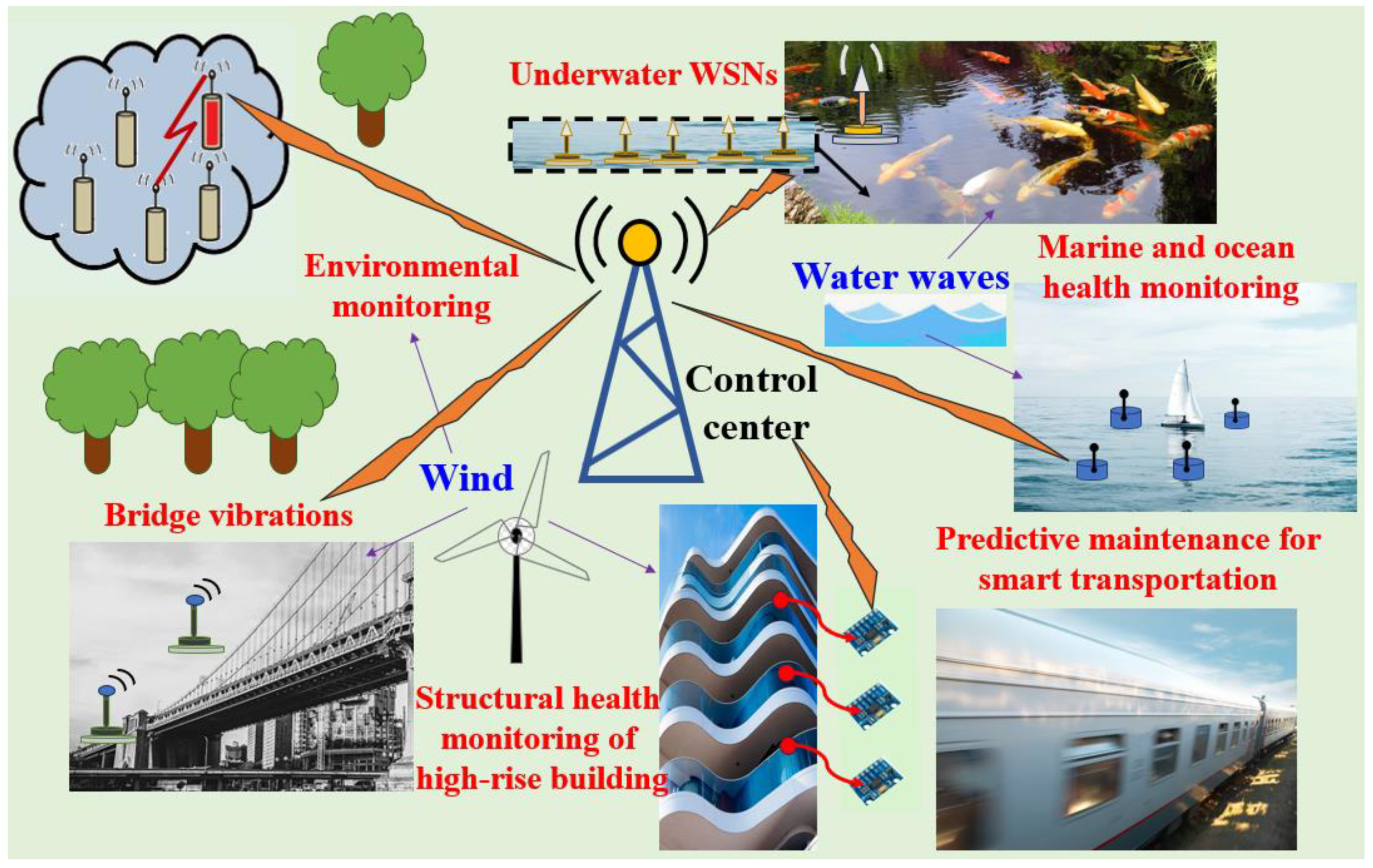
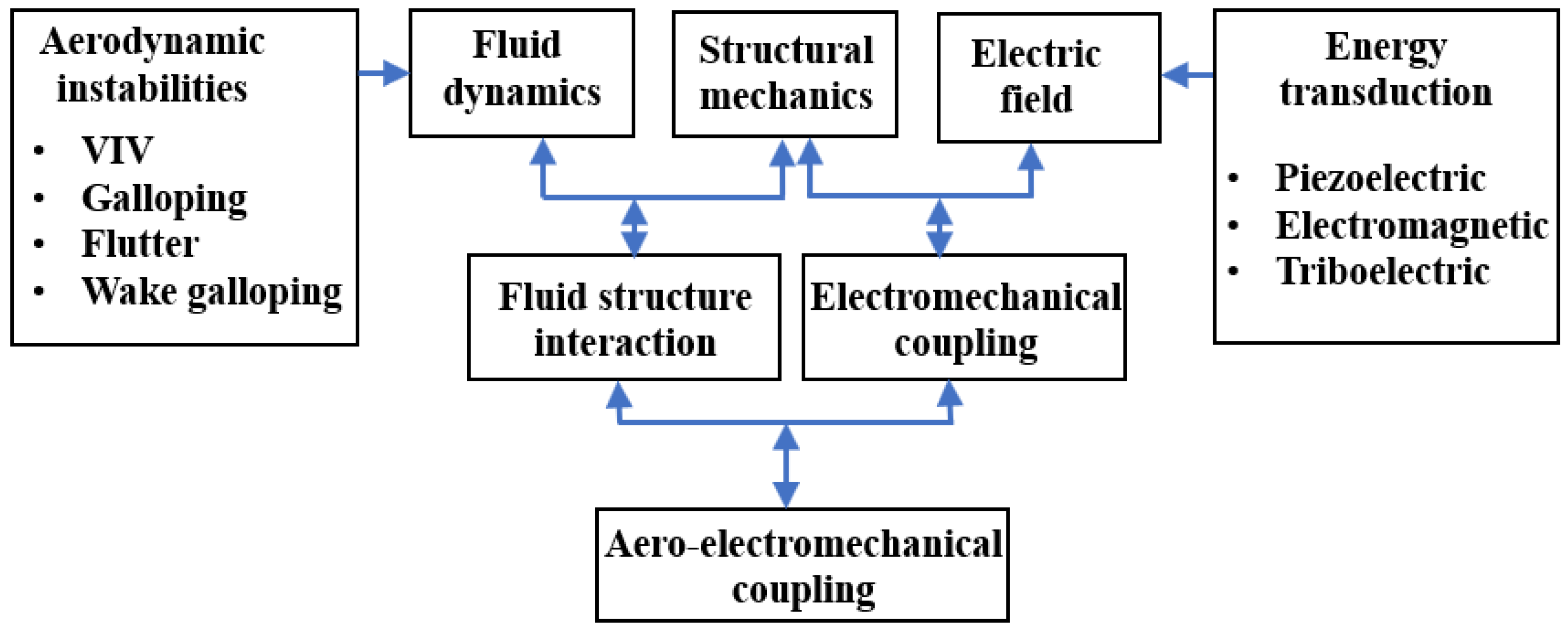

Disclaimer/Publisher’s Note: The statements, opinions and data contained in all publications are solely those of the individual author(s) and contributor(s) and not of MDPI and/or the editor(s). MDPI and/or the editor(s) disclaim responsibility for any injury to people or property resulting from any ideas, methods, instructions or products referred to in the content. |
© 2024 by the authors. Licensee MDPI, Basel, Switzerland. This article is an open access article distributed under the terms and conditions of the Creative Commons Attribution (CC BY) license (https://creativecommons.org/licenses/by/4.0/).
Share and Cite
Bakhtiar, S.; Khan, F.U.; Fu, H.; Hajjaj, A.Z.; Theodossiades, S. Fluid Flow-Based Vibration Energy Harvesters: A Critical Review of State-of-the-Art Technologies. Appl. Sci. 2024, 14, 11452. https://doi.org/10.3390/app142311452
Bakhtiar S, Khan FU, Fu H, Hajjaj AZ, Theodossiades S. Fluid Flow-Based Vibration Energy Harvesters: A Critical Review of State-of-the-Art Technologies. Applied Sciences. 2024; 14(23):11452. https://doi.org/10.3390/app142311452
Chicago/Turabian StyleBakhtiar, Sadia, Farid Ullah Khan, Hailing Fu, Amal Z. Hajjaj, and Stephanos Theodossiades. 2024. "Fluid Flow-Based Vibration Energy Harvesters: A Critical Review of State-of-the-Art Technologies" Applied Sciences 14, no. 23: 11452. https://doi.org/10.3390/app142311452
APA StyleBakhtiar, S., Khan, F. U., Fu, H., Hajjaj, A. Z., & Theodossiades, S. (2024). Fluid Flow-Based Vibration Energy Harvesters: A Critical Review of State-of-the-Art Technologies. Applied Sciences, 14(23), 11452. https://doi.org/10.3390/app142311452








